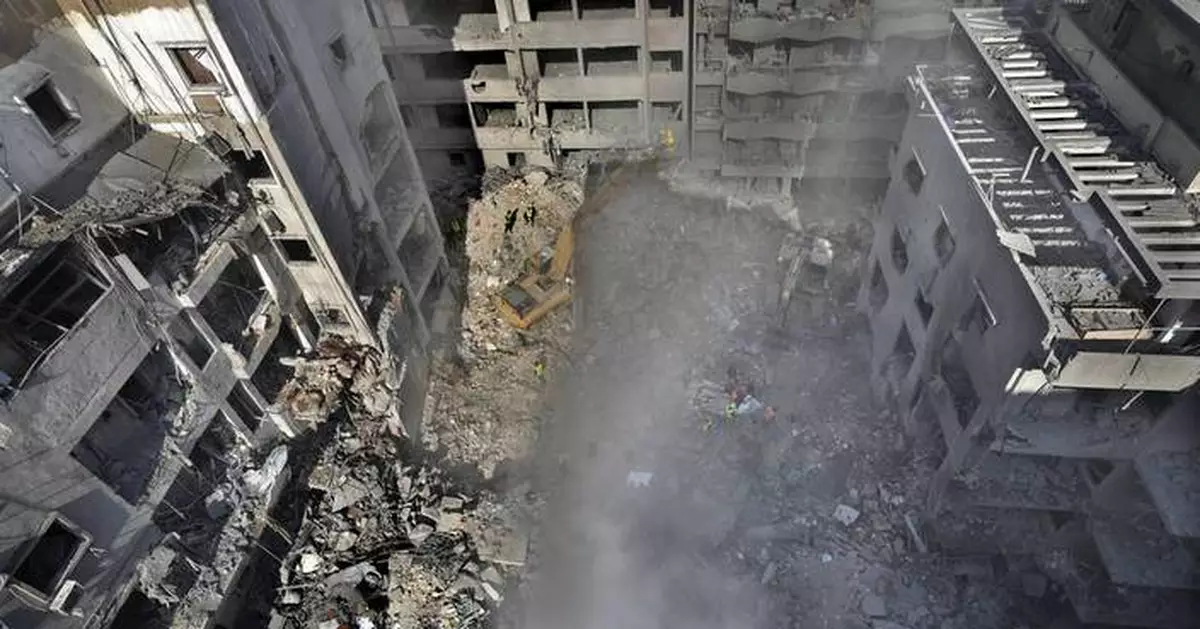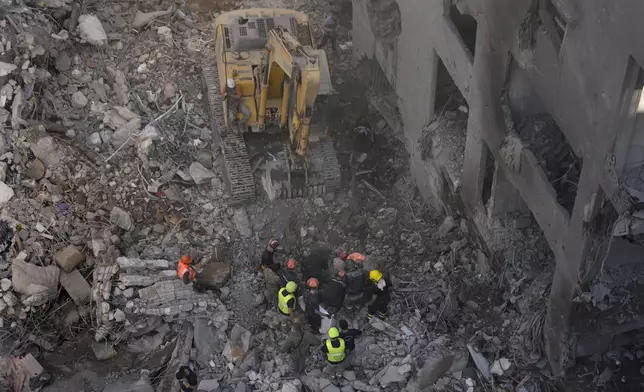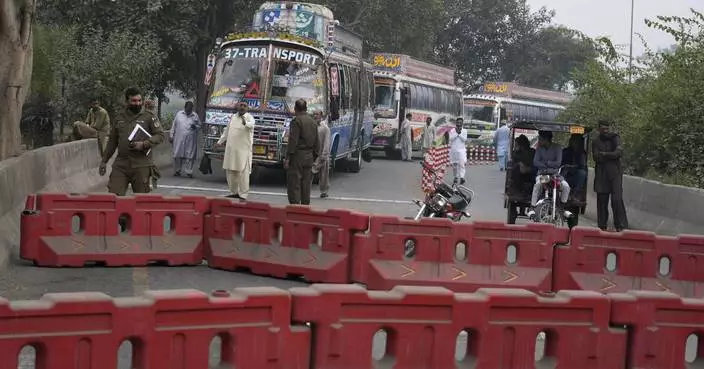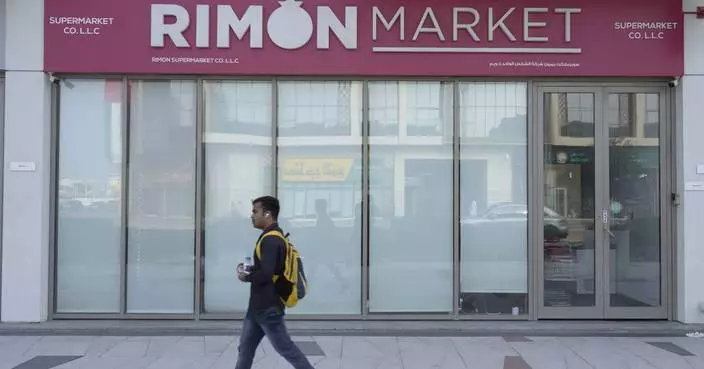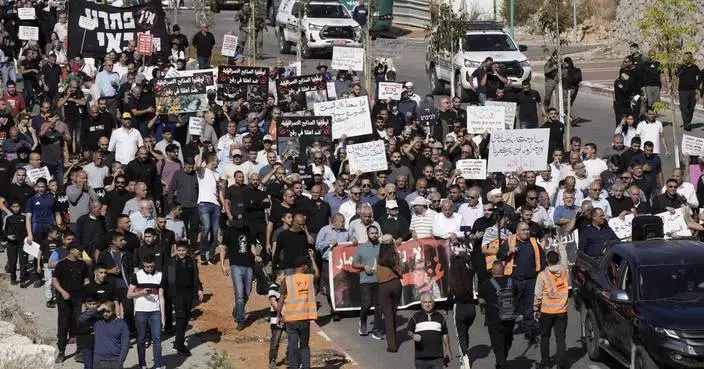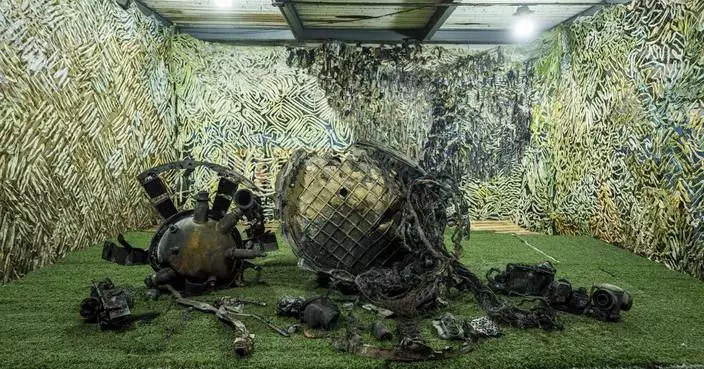BEIRUT (AP) — An Israeli strike on a Lebanese army center on Sunday killed one soldier and wounded 18 others, the Lebanese military said. The Hezbollah militant group meanwhile fired around 160 rockets and other projectiles into northern and central Israel, wounding at least five people.
Israeli strikes have killed over 40 Lebanese troops since the start of the war between Israel and Hezbollah, even as Lebanon's military has largely kept to the sidelines.
Click to Gallery
European Union foreign policy chief Josep Borrell, left, meets with Lebanese Parliament speaker Nabih Berri, right, in Beirut, Lebanon, Sunday, Nov. 24, 2024. (AP Photo/Hassan Ammar)
European Union foreign policy chief Josep Borrell gestures as he arrives for his meeting with Lebanese Parliament speaker Nabih Berri, in Beirut, Lebanon, Sunday, Nov. 24, 2024. (AP Photo/Hassan Ammar)
European Union foreign policy chief Josep Borrell, left, meets with Lebanese Parliament speaker Nabih Berri, righr, in Beirut, Lebanon, Sunday, Nov. 24, 2024. (AP Photo/Hassan Ammar)
Lebanese Parliament speaker Nabih Berri during his meeting with European Union foreign policy chief Josep Borrell, in Beirut, Lebanon, Sunday, Nov. 24, 2024. (AP Photo/Hassan Ammar)
Lebanese Parliament speaker Nabih Berri during his meeting with European Union foreign policy chief Josep Borrell, in Beirut, Lebanon, Sunday, Nov. 24, 2024. (AP Photo/Hassan Ammar)
European Union foreign policy chief Josep Borrell gives a statement to the media after his meeting with Lebanese Parliament speaker Nabih Berri, in Beirut, Lebanon, Sunday, Nov. 24, 2024. (AP Photo/Hassan Ammar)
European Union foreign policy chief Josep Borrell gives a statement to the media after his meeting with Lebanese Parliament speaker Nabih Berri, in Beirut, Lebanon, Sunday, Nov. 24, 2024. (AP Photo/Hassan Ammar)
Israeli police bomb squad inspect the site after a missile fired from Lebanon hit the area in Petah Tikva, outskirts of Tel Aviv, Israel, Sunday Nov. 24, 2024. (AP Photo/Oded Balilty)
Israeli police bomb squad inspect the site after a missile fired from Lebanon hit the area in Petah Tikva, outskirts of Tel Aviv, Israel, Sunday Nov. 24, 2024. (AP Photo/Oded Balilty)
Israeli police bomb squad inspect the site after a missile fired from Lebanon hit the area in Petah Tikva, outskirts of Tel Aviv, Israel, Sunday Nov. 24, 2024. (AP Photo/Oded Balilty)
Two men stand at the site of an Israeli airstrike that hit central Beirut, Lebanon, Saturday, Nov. 23, 2024. (AP Photo/Hussein Malla)
Rescue workers search for victims at the site of an Israeli airstrike that hit central Beirut, Lebanon, Saturday, Nov. 23, 2024. (AP Photo/Hussein Malla)
A firefighter extinguishes a fire at the site of an Israeli airstrike that hit central Beirut, Lebanon, Saturday, Nov. 23, 2024. (AP Photo/Hussein Malla)
Rescue workers search for victims at the site of an Israeli airstrike that hit central Beirut, Lebanon, Saturday, Nov. 23, 2024. (AP Photo/Hussein Malla)
The Israeli military expressed regret over the strike, saying it occurred in an area of ongoing combat operations against Hezbollah. It said in a statement that its operations are directed solely against Hezbollah and not the Lebanese military, and that the strike was under review.
Lebanon's caretaker prime minister, Najib Mikati, condemned it as an assault on U.S.-led cease-fire efforts, calling it a “direct, bloody message rejecting all efforts and ongoing contacts” to end the war.
“(Israel is) again writing in Lebanese blood a brazen rejection of the solution that is being discussed,” a statement from his office read.
The strike occurred in southwestern Lebanon on the coastal road between Tyre and Naqoura, where there has been heavy fighting between Israel and Hezbollah.
Hezbollah began firing rockets, missiles and drones into Israel after Hamas' Oct. 7, 2023, attack out of the Gaza Strip ignited the war there. Hezbollah has portrayed the attacks as an act of solidarity with the Palestinians and Hamas. Iran supports both armed groups.
Israel has launched retaliatory airstrikes since the rocket fire began, and in September the low-level conflict erupted into all-out war, as Israel launched waves of airstrikes across large parts of Lebanon and killed Hezbollah's top leader, Hassan Nasrallah, and several of his top commanders.
Hezbollah fired a total of around 160 rockets and other projectiles into Israel on Sunday, some of which were intercepted, the Israeli military said.
Israel’s Magen David Adom rescue service said it was treating two people in the central city of Petah Tikva, a 23-year-old man who was lightly wounded by a blast and a 70-year-old woman suffering from smoke inhalation from a car that caught fire. The first responders said they treated three other people in northern Israel, closer to the border, including a 60-year-old man in serious condition.
It was unclear whether the injuries and damage were caused by the rockets or interceptors.
Israeli airstrikes early Saturday pounded central Beirut, killing at least 20 people and wounding 66, according to Lebanon's Health Ministry.
Israeli attacks have killed more than 3,500 people in Lebanon, according to Lebanon’s Health Ministry. The fighting has displaced about 1.2 million people, or a quarter of Lebanon’s population.
On the Israeli side, about 90 soldiers and nearly 50 civilians have been killed by bombardments in northern Israel and in battle following Israel's ground invasion in early October. Around 60,000 Israelis have been displaced from the country's north.
The Biden administration has spent months trying to broker a cease-fire, and U.S. envoy Amos Hochstein was back in the region last week.
The European Union’s top diplomat called for more pressure on both Israel and Hezbollah to reach a deal, saying one was "pending with a final agreement from the Israeli government.”
Josep Borrell spoke Sunday after meeting with Mikati and Lebanese Parliament Speaker Nabih Berri, a Hezbollah ally who has been mediating with the group.
Borrell said the EU is ready to allocate 200 million euros ($208m) to assist the Lebanese military, which would deploy additional forces to the south.
The emerging agreement would pave the way for the withdrawal of Hezbollah militants and Israeli troops from southern Lebanon below the Litani River in accordance with the U.N. Security Council resolution that ended the 2006 war. Lebanese troops would patrol the area, with the presence of U.N. peacekeepers.
Lebanon's army reflects the religious diversity of the country and is respected as a national institution, but it does not have the military capability to impose its will on Hezbollah or resist Israel's invasion.
Goldenberg reported from Tel Aviv, Israel.
Find more of AP’s war coverage at https://apnews.com/hub/israel-hamas-war
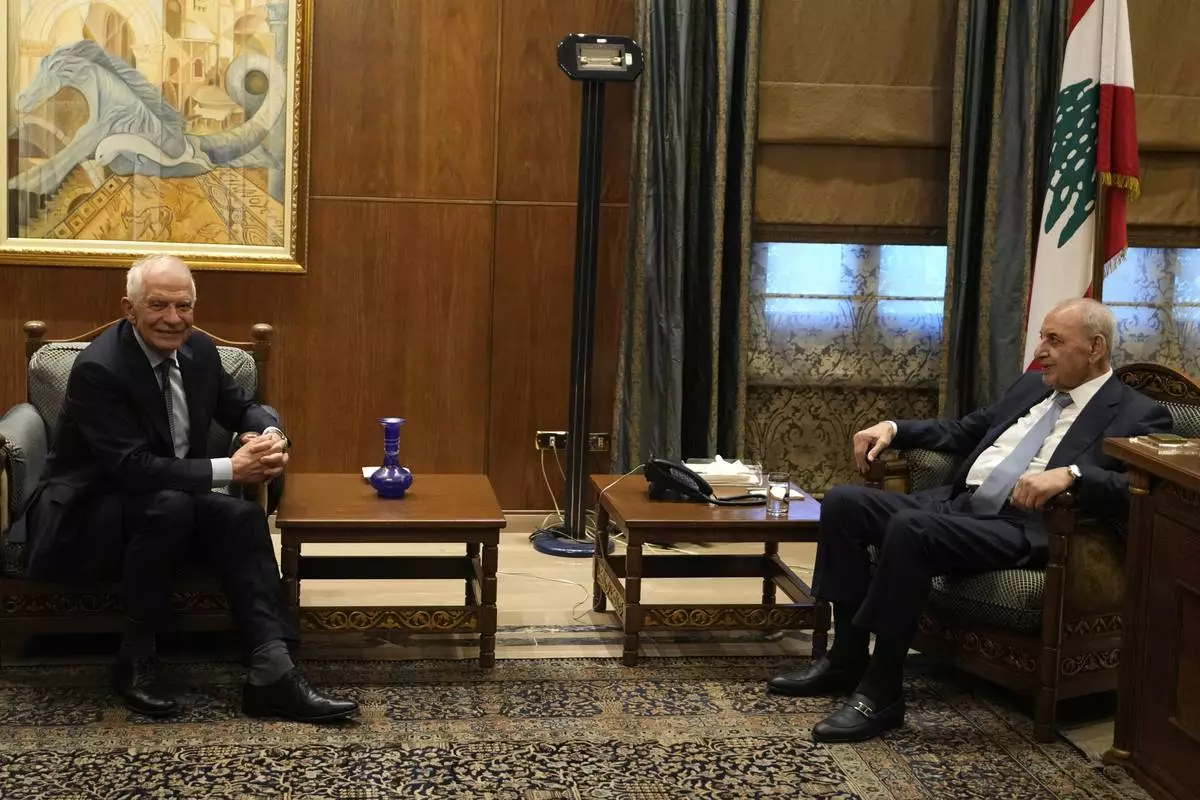
European Union foreign policy chief Josep Borrell, left, meets with Lebanese Parliament speaker Nabih Berri, right, in Beirut, Lebanon, Sunday, Nov. 24, 2024. (AP Photo/Hassan Ammar)
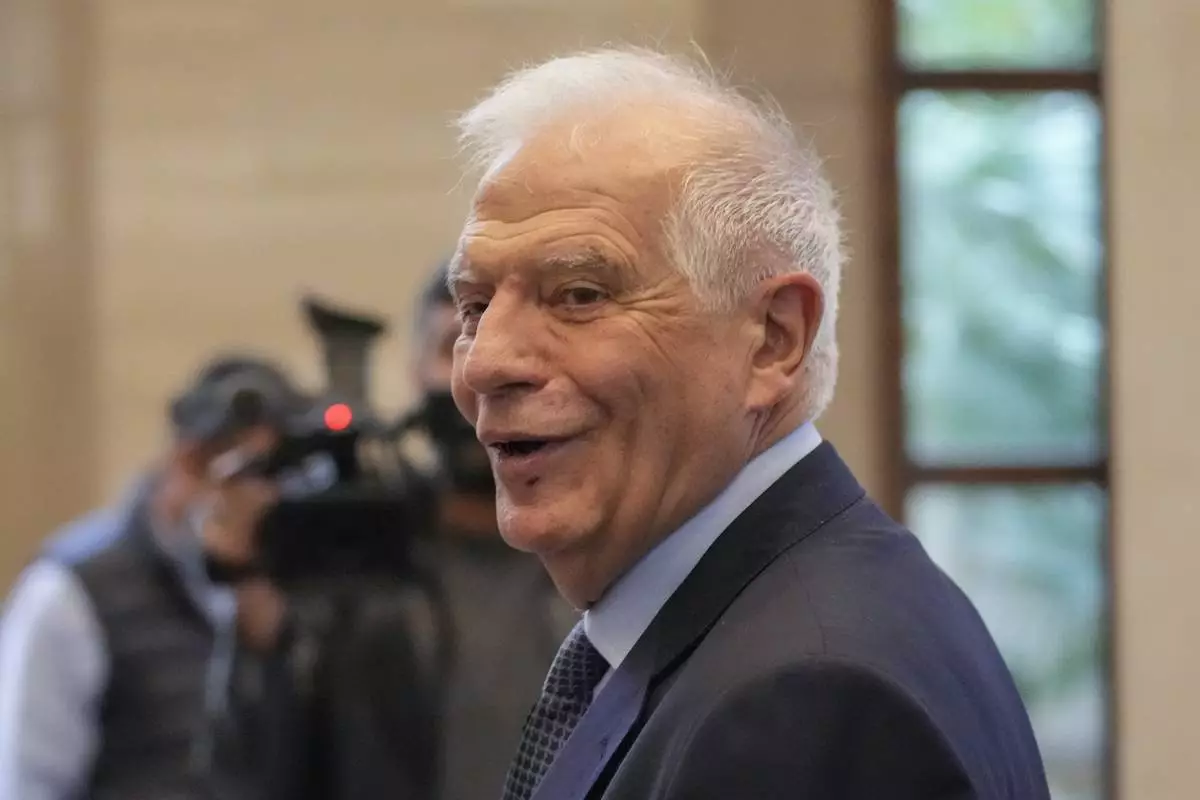
European Union foreign policy chief Josep Borrell gestures as he arrives for his meeting with Lebanese Parliament speaker Nabih Berri, in Beirut, Lebanon, Sunday, Nov. 24, 2024. (AP Photo/Hassan Ammar)
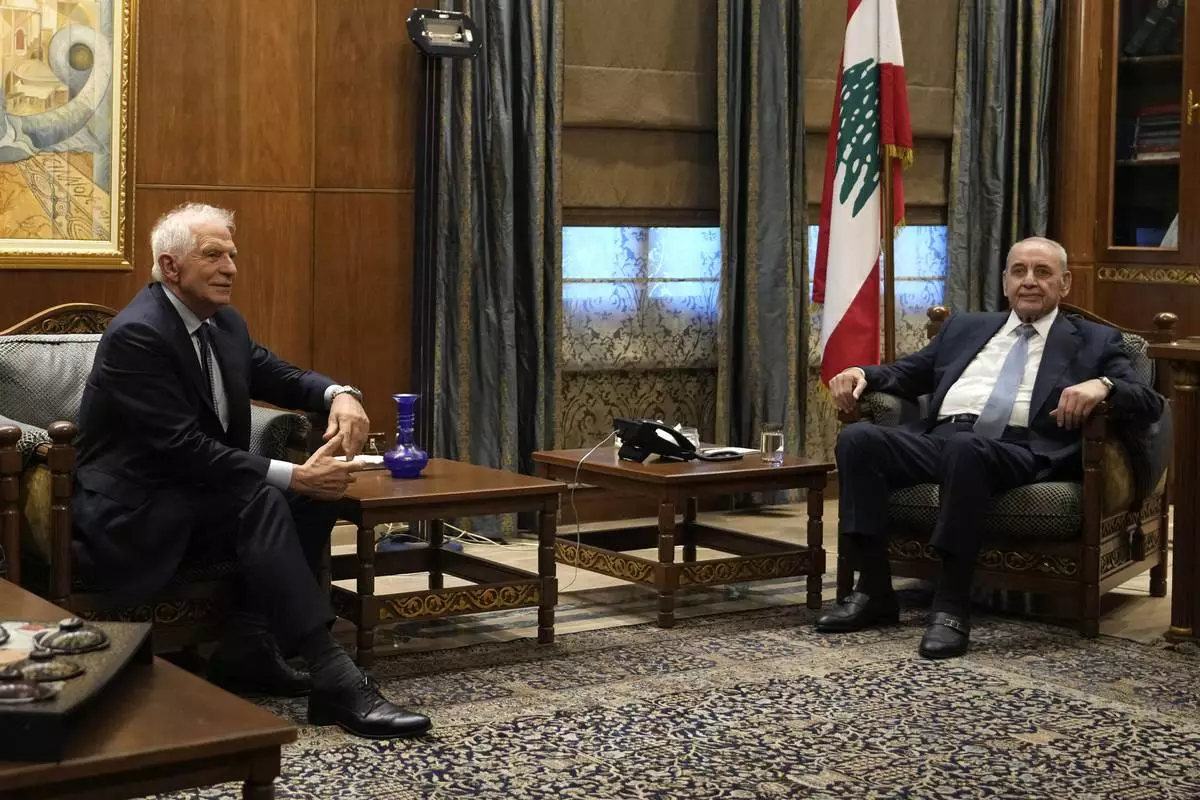
European Union foreign policy chief Josep Borrell, left, meets with Lebanese Parliament speaker Nabih Berri, righr, in Beirut, Lebanon, Sunday, Nov. 24, 2024. (AP Photo/Hassan Ammar)
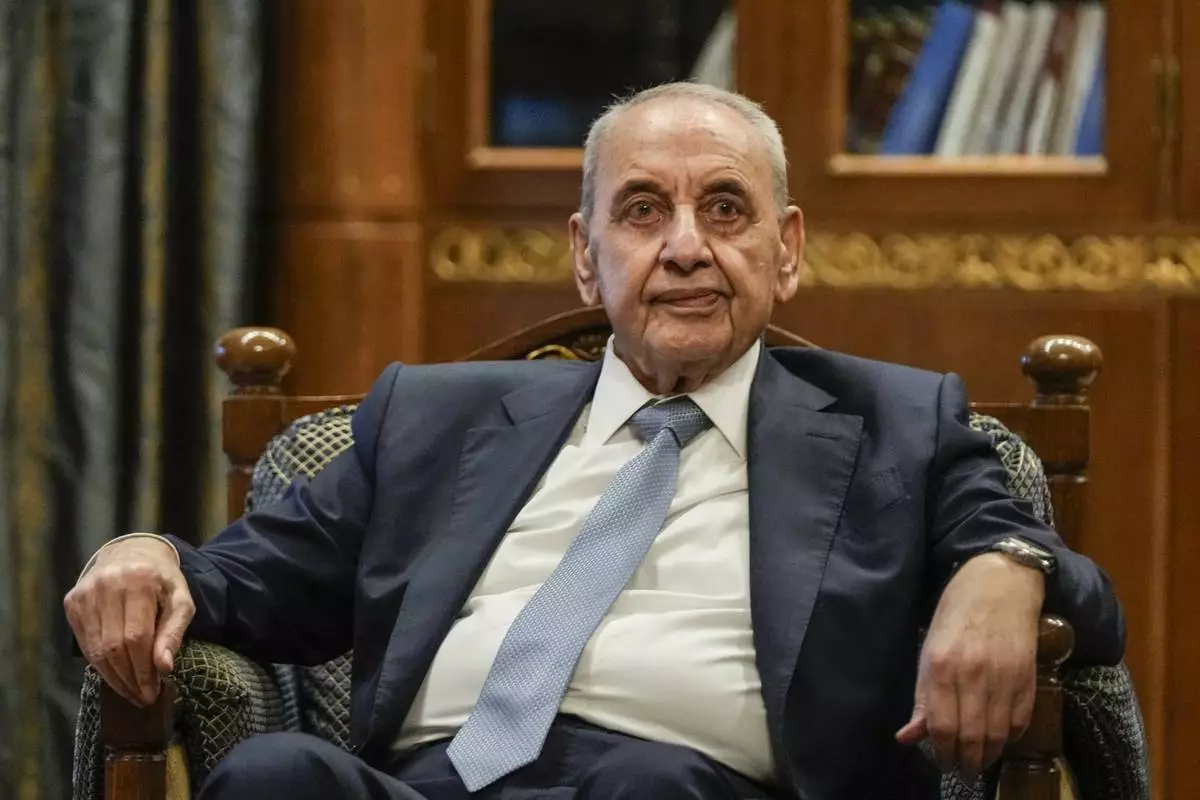
Lebanese Parliament speaker Nabih Berri during his meeting with European Union foreign policy chief Josep Borrell, in Beirut, Lebanon, Sunday, Nov. 24, 2024. (AP Photo/Hassan Ammar)
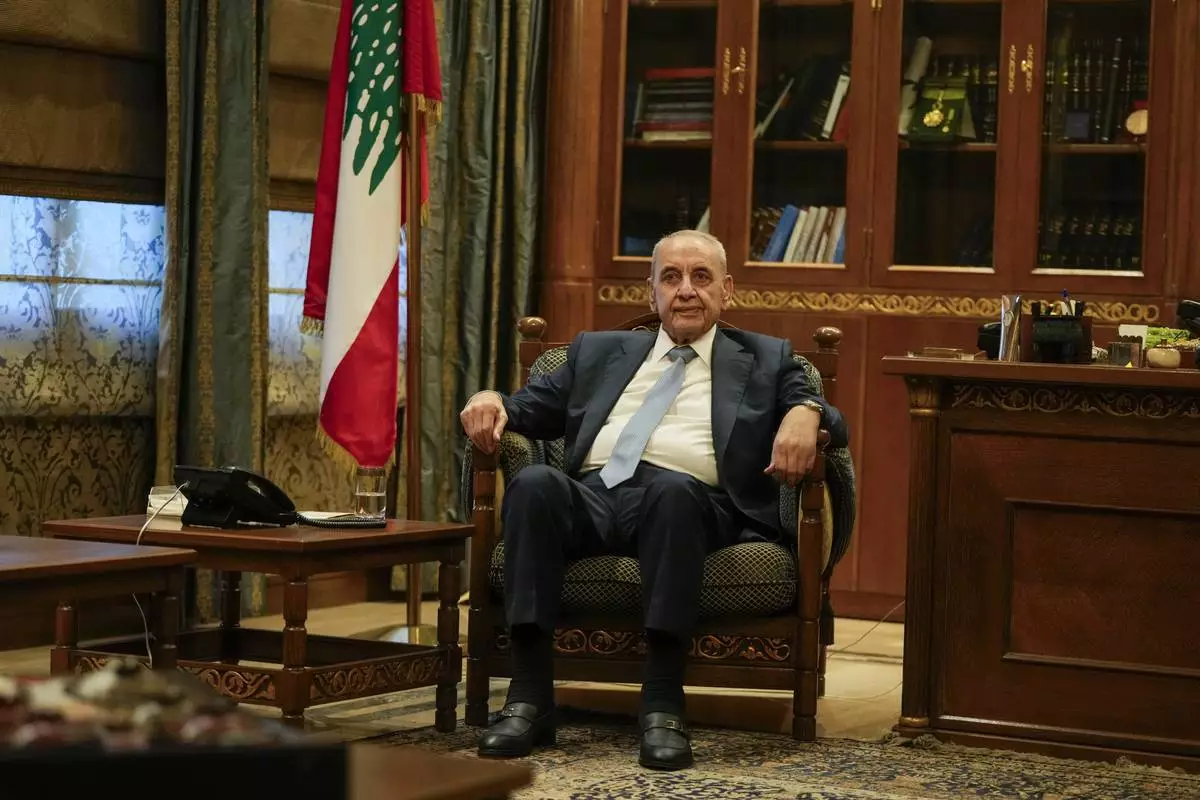
Lebanese Parliament speaker Nabih Berri during his meeting with European Union foreign policy chief Josep Borrell, in Beirut, Lebanon, Sunday, Nov. 24, 2024. (AP Photo/Hassan Ammar)
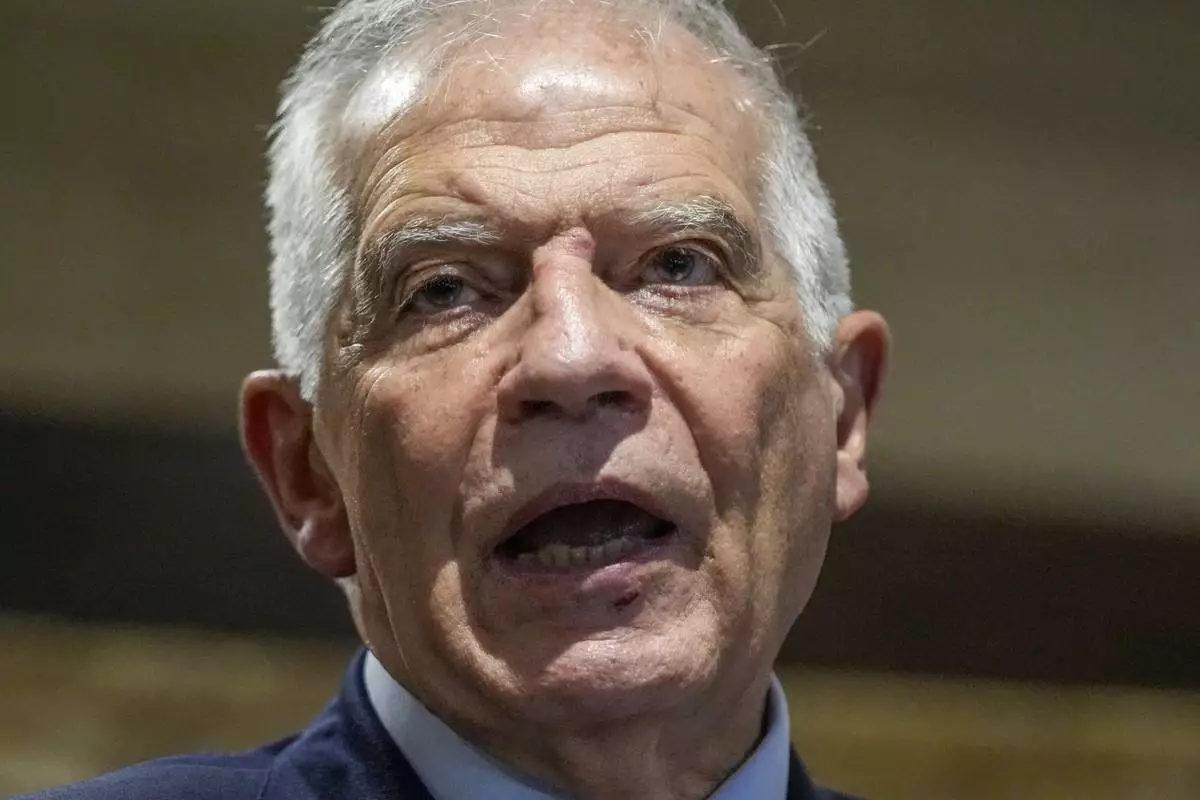
European Union foreign policy chief Josep Borrell gives a statement to the media after his meeting with Lebanese Parliament speaker Nabih Berri, in Beirut, Lebanon, Sunday, Nov. 24, 2024. (AP Photo/Hassan Ammar)

European Union foreign policy chief Josep Borrell gives a statement to the media after his meeting with Lebanese Parliament speaker Nabih Berri, in Beirut, Lebanon, Sunday, Nov. 24, 2024. (AP Photo/Hassan Ammar)
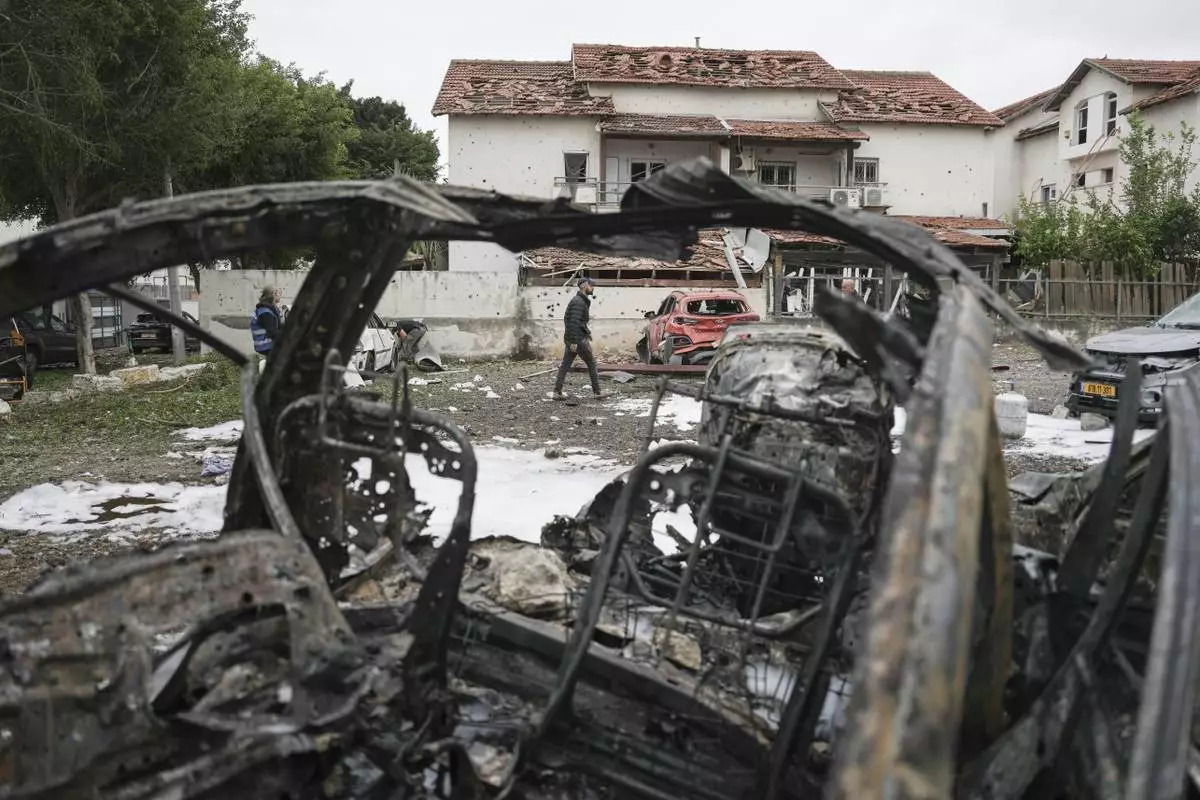
Israeli police bomb squad inspect the site after a missile fired from Lebanon hit the area in Petah Tikva, outskirts of Tel Aviv, Israel, Sunday Nov. 24, 2024. (AP Photo/Oded Balilty)
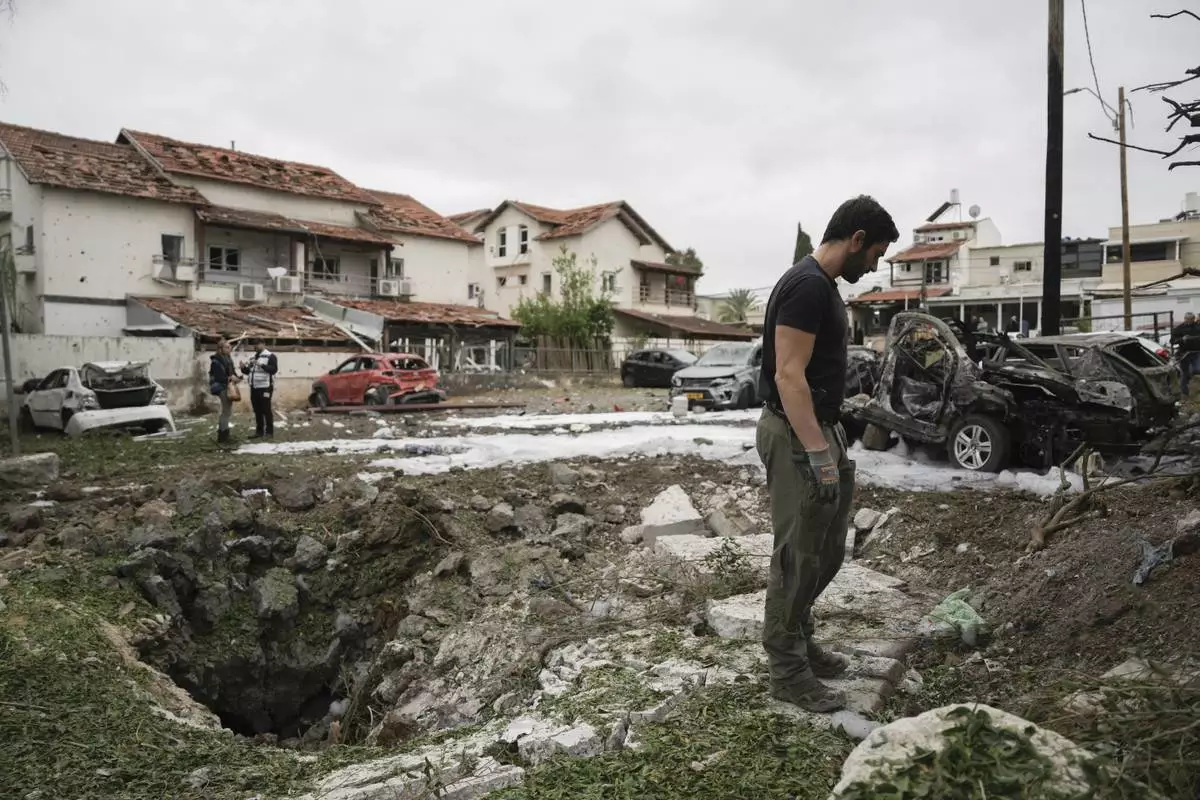
Israeli police bomb squad inspect the site after a missile fired from Lebanon hit the area in Petah Tikva, outskirts of Tel Aviv, Israel, Sunday Nov. 24, 2024. (AP Photo/Oded Balilty)
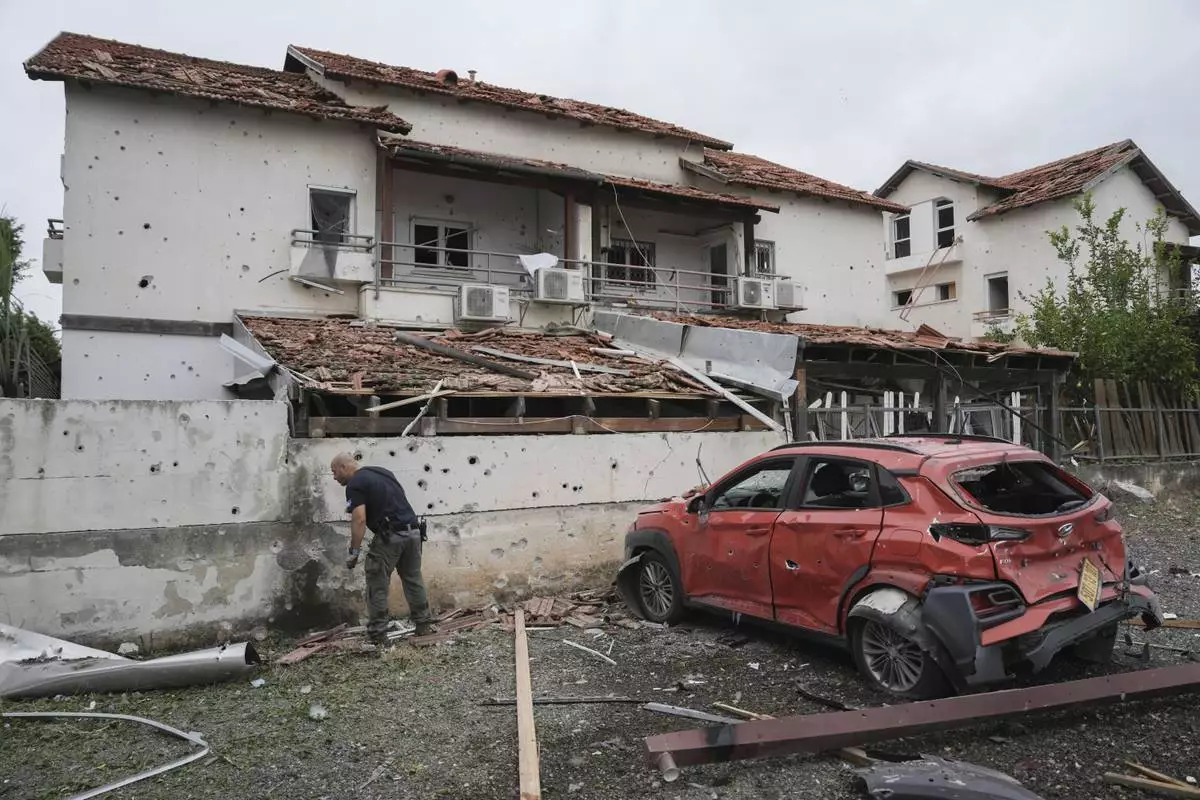
Israeli police bomb squad inspect the site after a missile fired from Lebanon hit the area in Petah Tikva, outskirts of Tel Aviv, Israel, Sunday Nov. 24, 2024. (AP Photo/Oded Balilty)
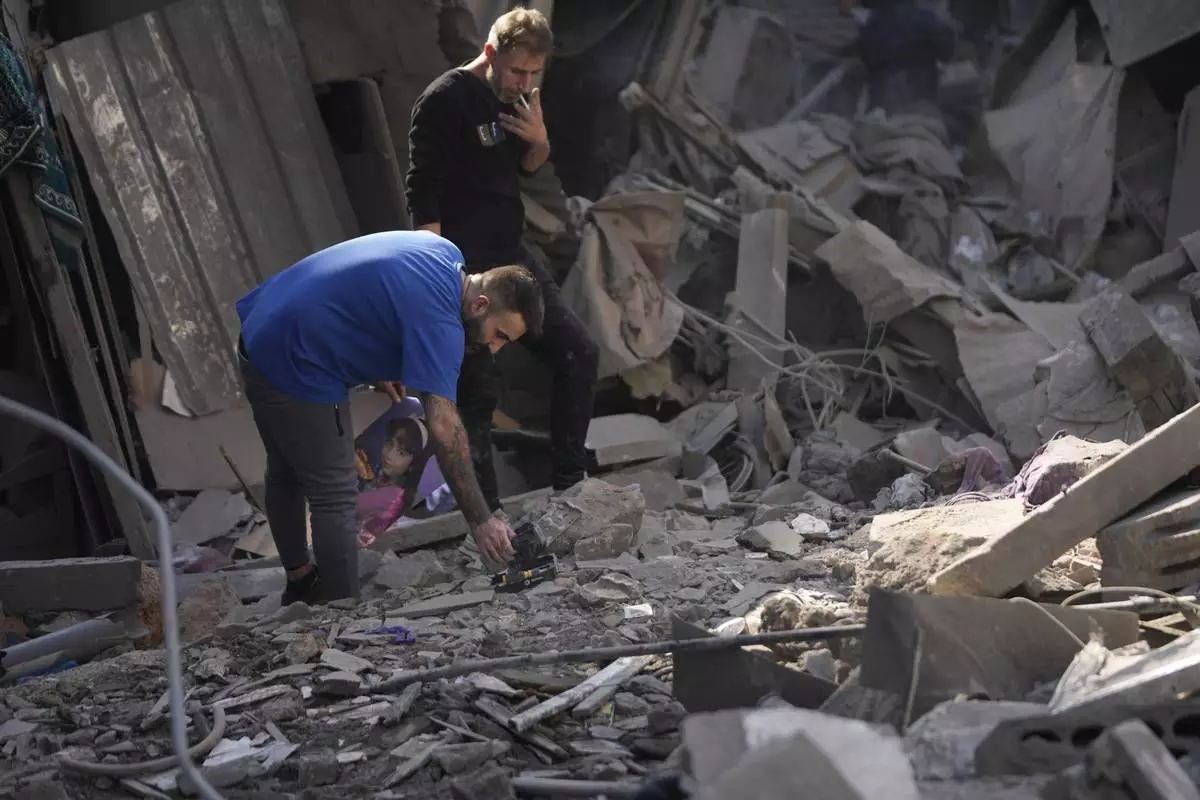
Two men stand at the site of an Israeli airstrike that hit central Beirut, Lebanon, Saturday, Nov. 23, 2024. (AP Photo/Hussein Malla)

Rescue workers search for victims at the site of an Israeli airstrike that hit central Beirut, Lebanon, Saturday, Nov. 23, 2024. (AP Photo/Hussein Malla)
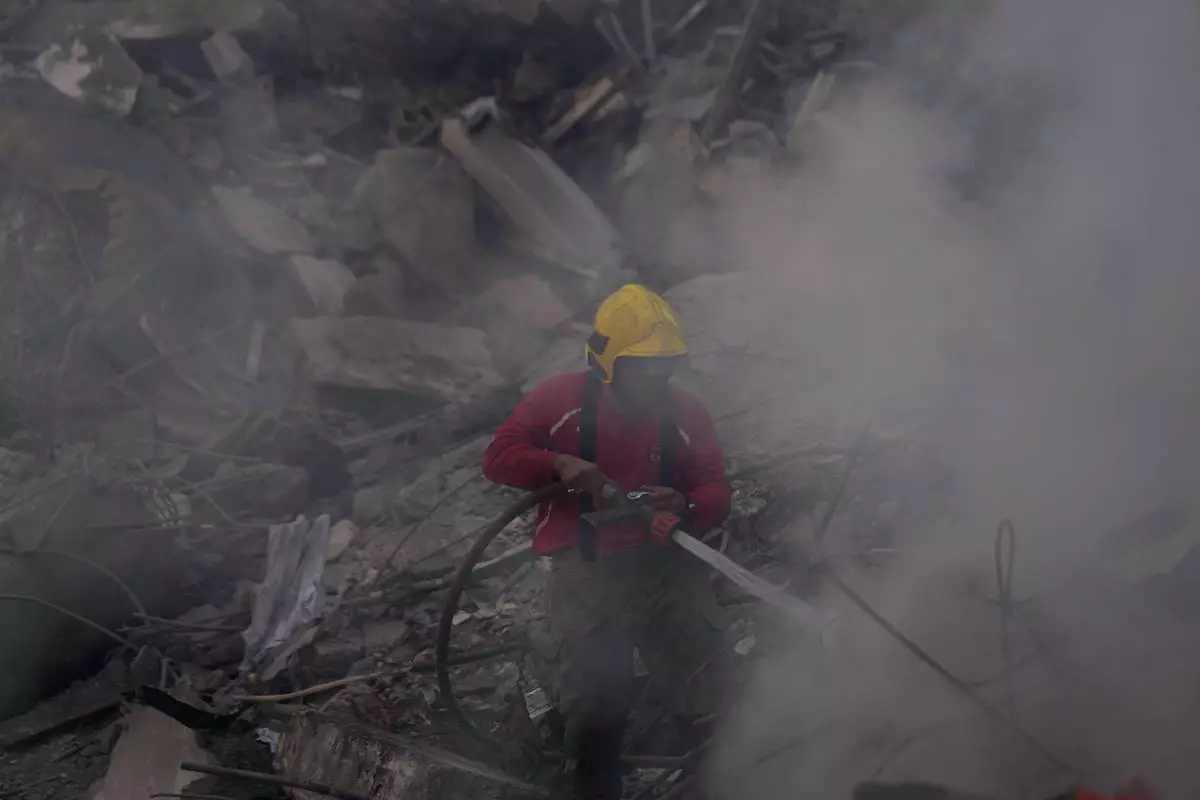
A firefighter extinguishes a fire at the site of an Israeli airstrike that hit central Beirut, Lebanon, Saturday, Nov. 23, 2024. (AP Photo/Hussein Malla)
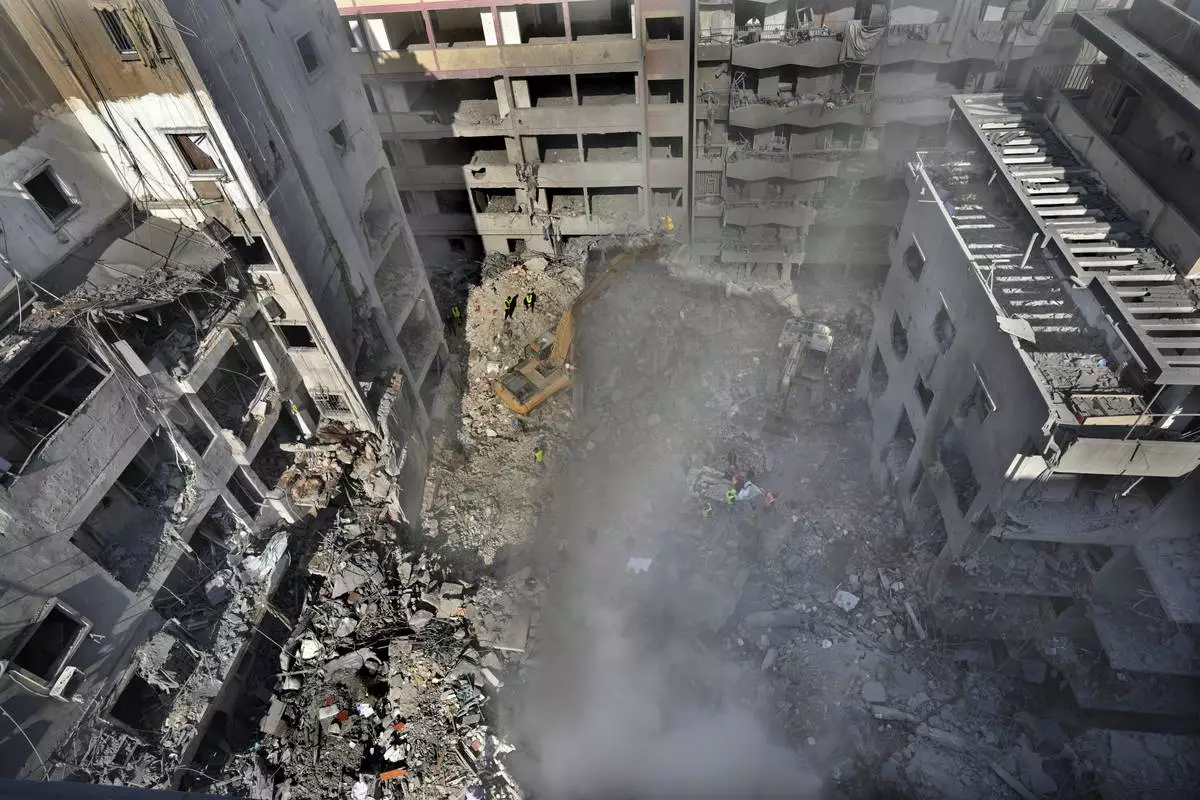
Rescue workers search for victims at the site of an Israeli airstrike that hit central Beirut, Lebanon, Saturday, Nov. 23, 2024. (AP Photo/Hussein Malla)
SADO, Japan (AP) — Japan held a memorial ceremony on Sunday near the Sado Island Gold Mines, listed this summer as a UNESCO World Heritage site after the country moved past years of historical disputes with South Korea and reluctantly acknowledged the mines' dark history. However, it has not offered an apology.
At these mines, hundreds of Koreans were forced to labor under abusive and brutal conditions during World War II, historians say. Japanese officials at Sunday’s ceremony time paid tribute for the first to “all workers” including Korean laborers who died at the mines, without acknowledging they were forced laborers — part of what critics call a persistent policy of whitewashing Japan's history of sexual and labor exploitation before and during the war.
The ceremony, supposed to further mend wounds, renewed tensions between the two sides. South Korea boycotted Sunday's memorial service citing unspecified disagreements with Tokyo over the event.
“As a resident, I must say (their absence) is very disappointing after all the preparations we made,” said Sado Mayor Ryugo Watanabe. “I wish we could have held the memorial with South Korean attendees.”
The Associated Press explains the Sado mines, their history and the controversy.
The 16th-century mines on the island of Sado, about the size of the Pacific island of Guam, off the western coast of Niigata prefecture, operated for nearly 400 years, beginning in 1601, and were once the world’s largest gold producer. They closed in 1989. During the Edo period, from 1603 to 1868, the mines supplied gold currency to the ruling Tokugawa Shogunate.
Today, the site has been developed into a tourist facility and hiking site where visitors can learn about the changes in mining technology and production methods while looking at the remains of mine shafts and ore dressing facilities.
Critics say the Japanese government only highlights the glory of the mines and covers up its use of Korean victims of forced labor and their ordeals. The mines were registered as a cultural heritage site in July after Japan agreed to include an exhibit on the conditions of Korean forced laborers and to hold a memorial service annually after repeated protests from the South Korean government.
A few signs have since been erected, indicating former sites of South Korean laborers’ dormitories. A city-operated museum in the area also added a section about Korean laborers, but a private museum attached to the main UNESCO site doesn't mention them at all.
At the UNESCO World Heritage Committee July meeting, the Japanese delegate said Tokyo had installed new exhibition material to explain the “severe conditions of (the Korean laborers’) work and to remember their hardship.”
Japan also acknowledged that Koreans were made to do more dangerous tasks in the mine shaft, which caused some to die. Those who survived also developed lung diseases and other health problems. Many of them were given meager food rations and nearly no days off and were caught by police if they escaped, historians say. But the Japanese government has refused to admit they were “forced labor.”
South Korea had earlier opposed the listing of the site for UNESCO World Heritage on the grounds that the Korean forced laborers used at the mines were missing from the exhibition. South Korea eventually supported the listing after consultations with Japan and Tokyo’s pledge to improve the historical background of the exhibit and to hold a memorial that also includes Koreans.
Historians say Japan used hundreds of thousands of Korean laborers, including those forcibly brought from the Korean Peninsula, at Japanese mines and factories to make up for labor shortages because most working-age Japanese men had been sent to battlefronts across Asia and the Pacific. About 1,500 Koreans were forced to work at the Sado mines, according to Yasuto Takeuchi, an expert on Japan’s wartime history, citing wartime Japanese documents.
The South Korean government has said it expects Japan to keep its pledge to be truthful to history and to show both sides of the Sado mines.
“The controversy surrounding the Sado mines exhibit underscores a deeper problem” of Japan’s failure to face up to its wartime responsibility and its growing “denialism” of its wartime atrocities, Takeuchi said.
All workers who died at the Sado mines were honored. That includes hundreds of Korean laborers who worked there during Japan’s 1910-1945 colonization of the Korean Peninsula.
At Sunday’s ceremony, four Japanese representatives, including central and local government officials and the head of the organizing group, thanked all mine workers for their sacrifice and mourned for those who died. None offered any apology to Korean forced laborers for the harsh treatment at the mines.
Attendants observed a moment of silence for the victims who died at the mines due to accidents and other causes.
The ceremony dredged up long-standing frustrations in South Korea.
About 100 people, including officials from Japan’s local and central government, as well as South Korean Foreign Ministry officials and the relatives of Korean wartime laborers, were supposed to attend. Because of South Korea's last-minute boycott, more than 20 seats remained vacant.
The Foreign Ministry said in a statement Saturday it was impossible to settle the disagreements between both governments before the planned event on Sunday, without specifying what those disagreements were.
There has been speculation that the South Korean boycott might have been due to the presence of parliamentary vice minister Akiko Ikuina at Sunday's ceremony. In August 2022, Ikuina reportedly visited Tokyo’s controversial Yasukuni Shrine, weeks after she was elected as a lawmaker. Japan’s neighbors view Yasukuni, which commemorates 2.5 million war dead including war criminals, as a symbol of Japan’s past militarism. Her visit could have been seen as a sign of a lack of remorse.
Some South Koreans criticized the Seoul government for throwing its support behind an event without securing a clear Japanese commitment to highlight the plight of Korean laborers. There were also complaints over South Korea agreeing to pay for the travel expenses of Korean victims’ family members who were invited to attend the ceremony.
Critics say Japan’s government has long been reluctant to discuss wartime atrocities. That includes what historians describe as the sexual abuse and enslavement of women across Asia, many of them Koreans who were deceived into providing sex to Japanese soldiers at frontline brothels and euphemistically called “comfort women,” and the Koreans who were mobilized and forced to work in Japan, especially in the final years of World War II.
Korean compensation demands for Japanese atrocities during its brutal colonial rule have strained relations between the two Asian neighbors, most recently after a 2018 South Korean Supreme Court ruling ordered Japanese companies to pay damages over their wartime forced labor.
Japan’s government has maintained that all wartime compensation issues between the two countries were resolved under the 1965 normalization treaty. Ties between Tokyo and Seoul have improved recently after Washington said their disputes over historical issues hampered crucial security cooperation as China’s threat grows in the region.
South Korea’s conservative President Yoon Suk Yeol announced in March 2023 that his country would use a local corporate fund to compensate forced labor victims without demanding Japanese contributions. Japan’s then-Prime Minister Fumio Kishida later expressed sympathy for their suffering during a Seoul visit. Security, business and other ties between the sides have since rapidly resumed.
Japan’s whitewashing of wartime atrocities has risen since the 2010s, particularly under the past government of revisionist leader Shinzo Abe. For instance, Japan says the terms “sex slavery” and “forced labor” are inaccurate and insists on the use of highly euphemistic terms such as “comfort women” and “civilian workers” instead.
Takeuchi, the historian, said listing Japan’s modern industrial historical sites as a UNESCO World Heritage is a government push to increase tourism. The government, he said, wants “to commercialize sites like the Sado mines by beautifying and justifying their history for Japan’s convenience.”
Associated Press writer Kim Tong-hyung in Seoul, South Korea contributed to this report.
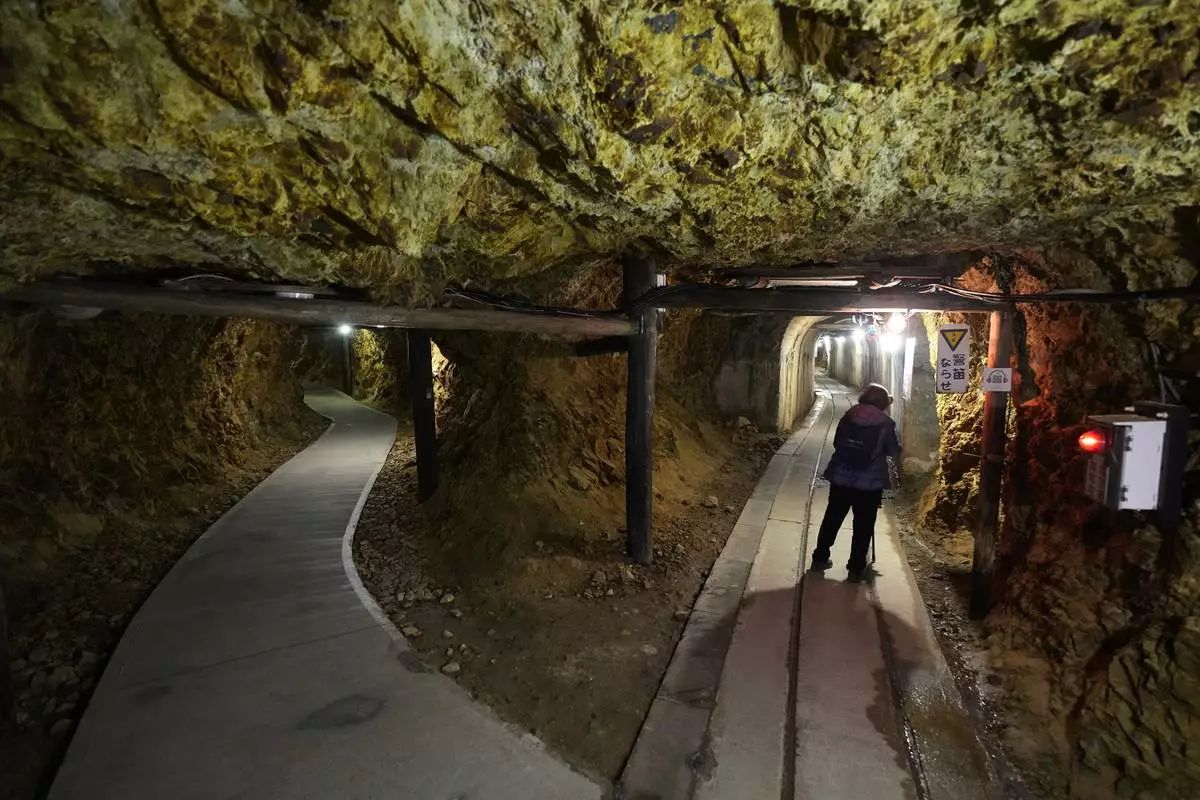
A visitor walk through tunnels at Sado Kinzan Gold Mine historic site in Sado, Niigata prefecture, Japan, Sunday, Nov. 24, 2024. (AP Photo/Eugene Hoshiko)
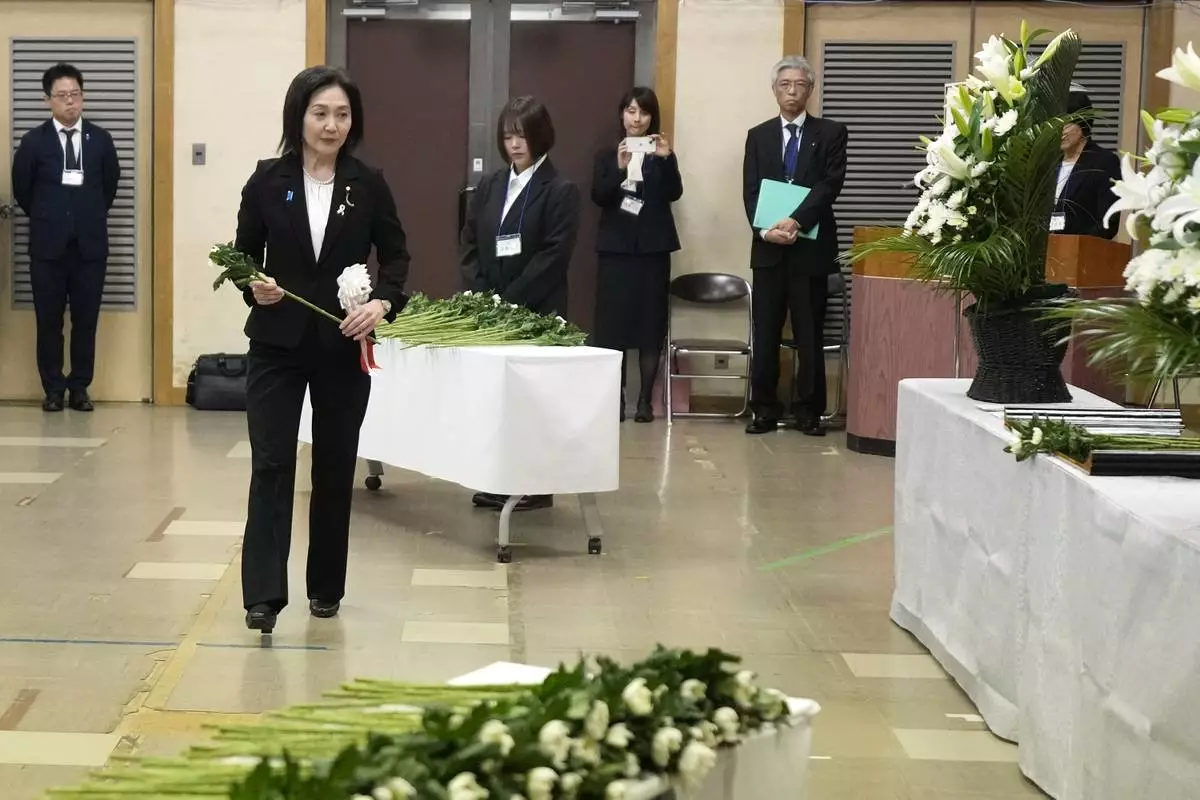
Akiko Ikuina, Parliamentary Vice-Minister for Foreign Affairs, offer a flower on behalf of the government during a memorial ceremony for the Sado Island Gold Mine in Sado, Niigata prefecture, Japan, Sunday, Nov. 24, 2024. (AP Photo/Eugene Hoshiko)
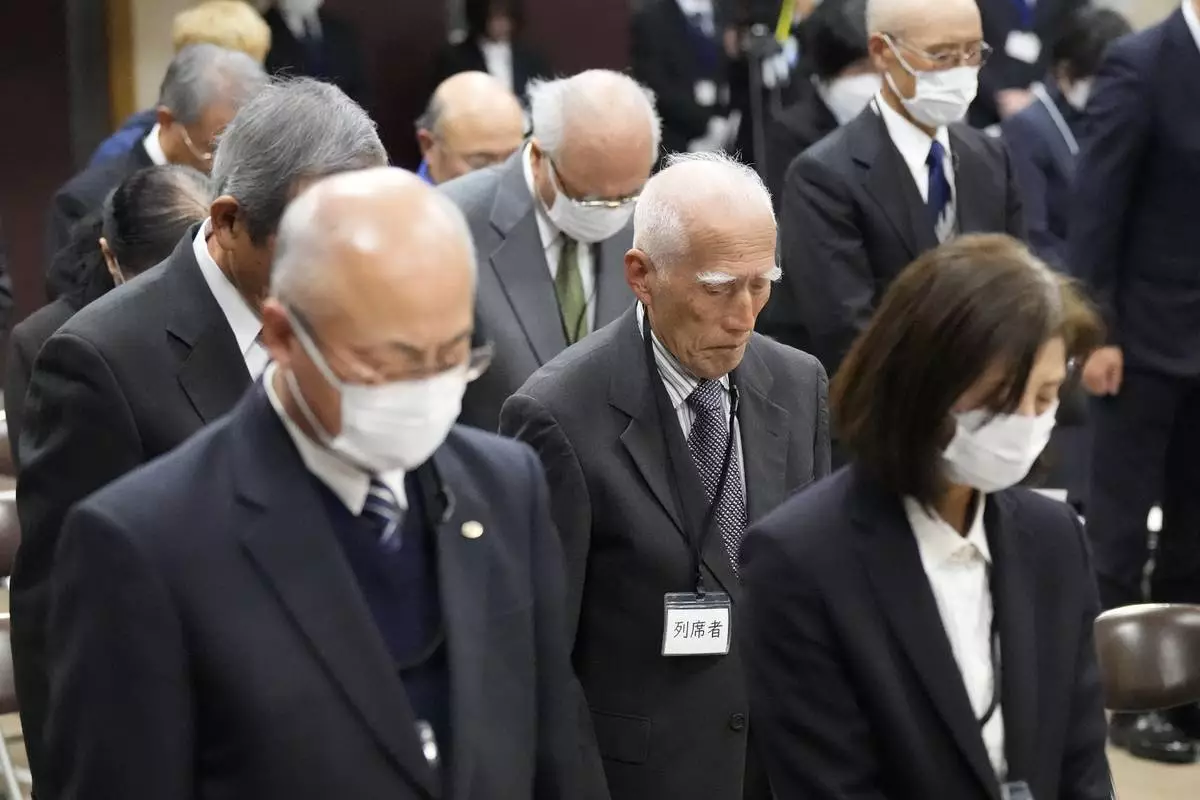
Guests offer a moment of silence during a memorial ceremony for the Sado Island Gold Mine in Sado, Niigata prefecture, Japan, Sunday, Nov. 24, 2024. (AP Photo/Eugene Hoshiko)

Akiko Ikuina, Parliamentary Vice-Minister for Foreign Affairs, offer a flower on behalf of the government during a memorial ceremony for the Sado Island Gold Mine in Sado, Niigata prefecture, Japan, Sunday, Nov. 24, 2024. (AP Photo/Eugene Hoshiko)
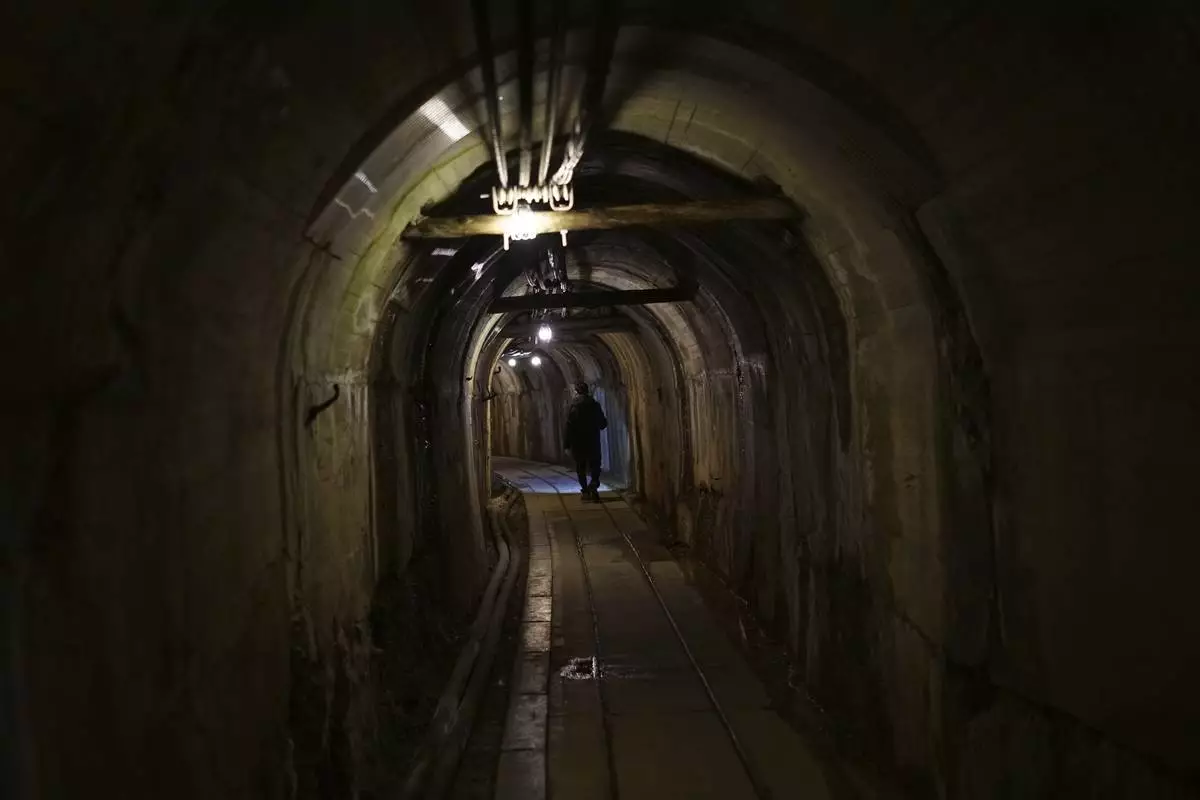
A staff walks through a tunnel at Sado Kinzan Gold Mine historic site in Sado, Niigata prefecture, Japan, Sunday, Nov. 24, 2024. (AP Photo/Eugene Hoshiko)
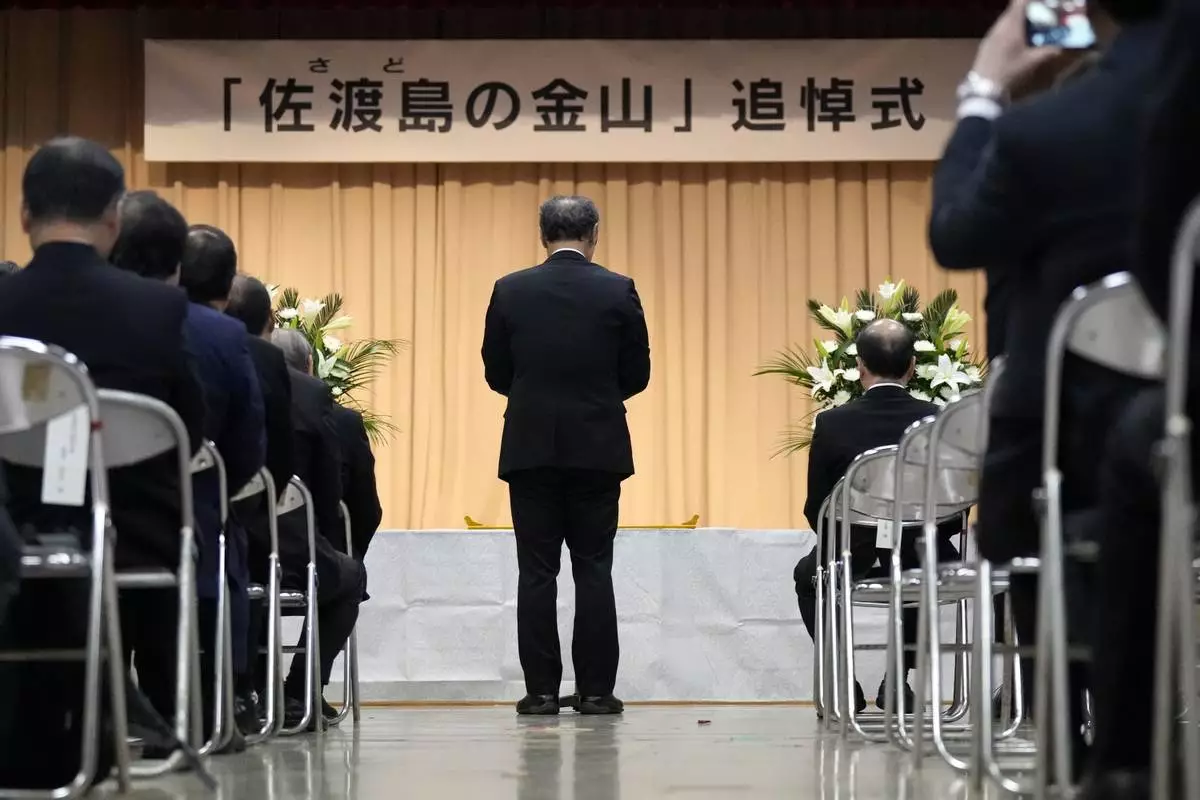
Mayor of Sado City Ryugo Watanabe delivers a speech during a memorial ceremony for the Sado Island Gold Mine in Sado, Niigata prefecture, Japan, Sunday, Nov. 24, 2024. (AP Photo/Eugene Hoshiko)
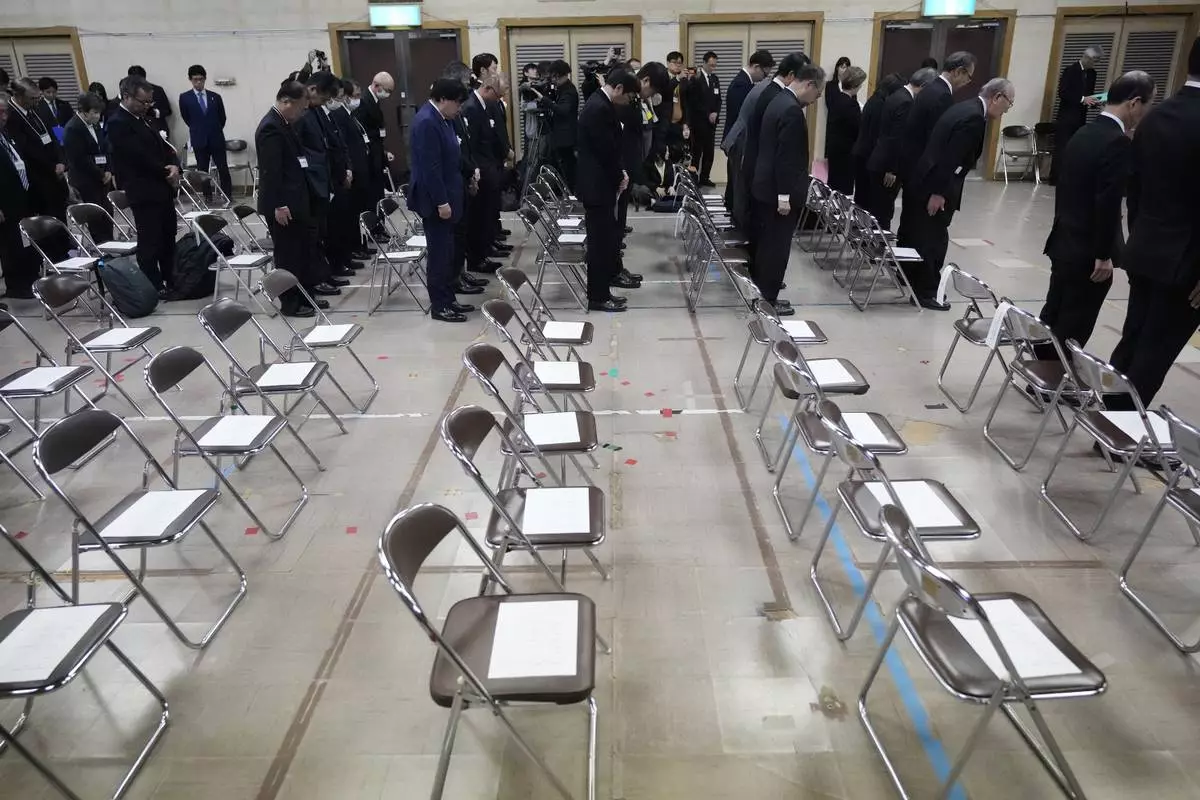
Guests offer a moment of silence during a memorial ceremony for the Sado Island Gold Mine in Sado, Niigata prefecture, Japan, as several seats reserved for South Korean guests remained empty Sunday, Nov. 24, 2024. (AP Photo/Eugene Hoshiko)
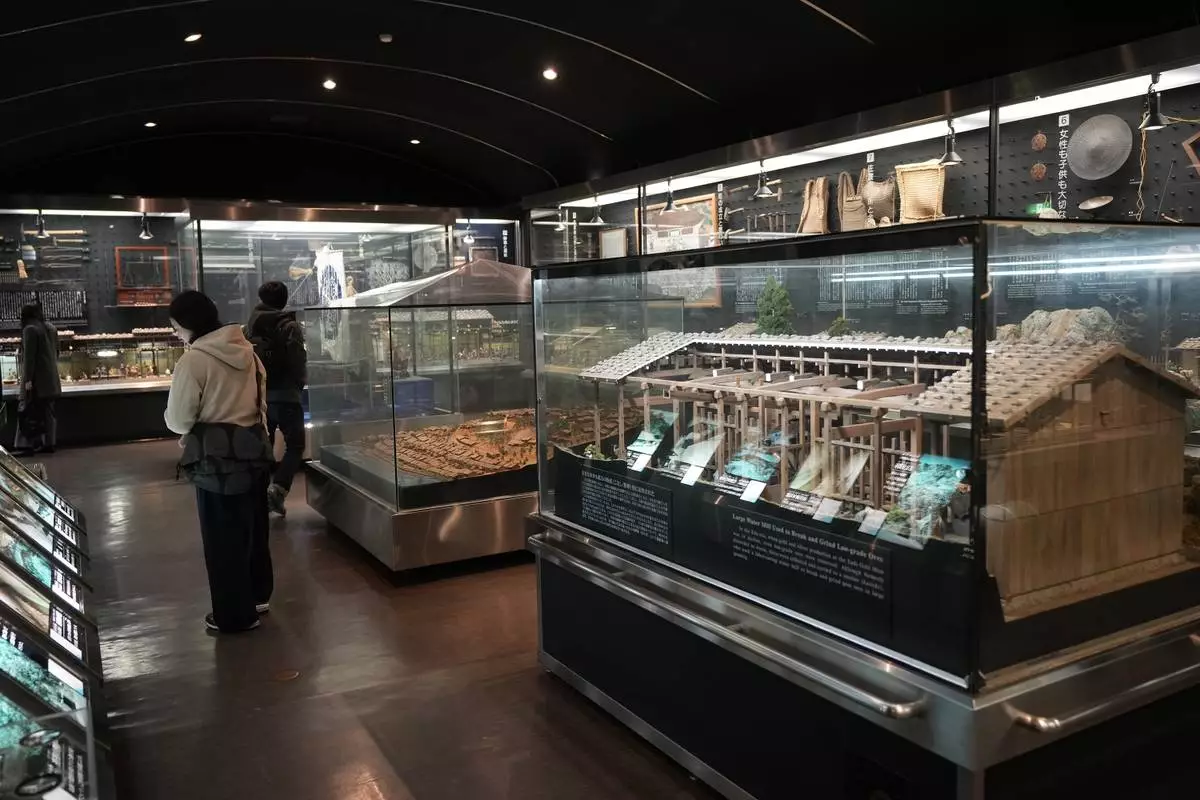
Visitors look at the display at Sado Kinzan Gold Mine historic site in Sado, Niigata prefecture, Japan, Saturday, Nov. 23, 2024. (AP Photo/Eugene Hoshiko)
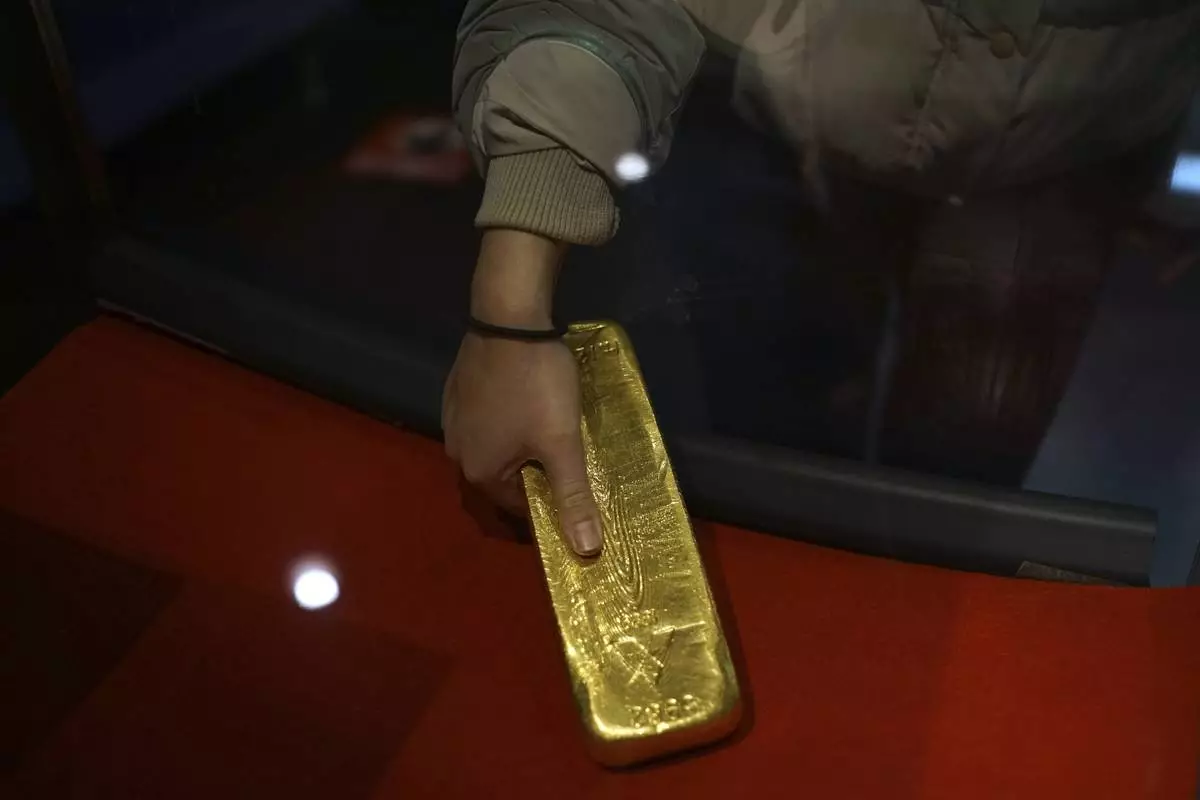
A visitor tries to pick up a gold bar at Sado Kinzan Gold Mine historic site in Sado, Niigata prefecture, Japan, Saturday, Nov. 23, 2024. (AP Photo/Eugene Hoshiko)
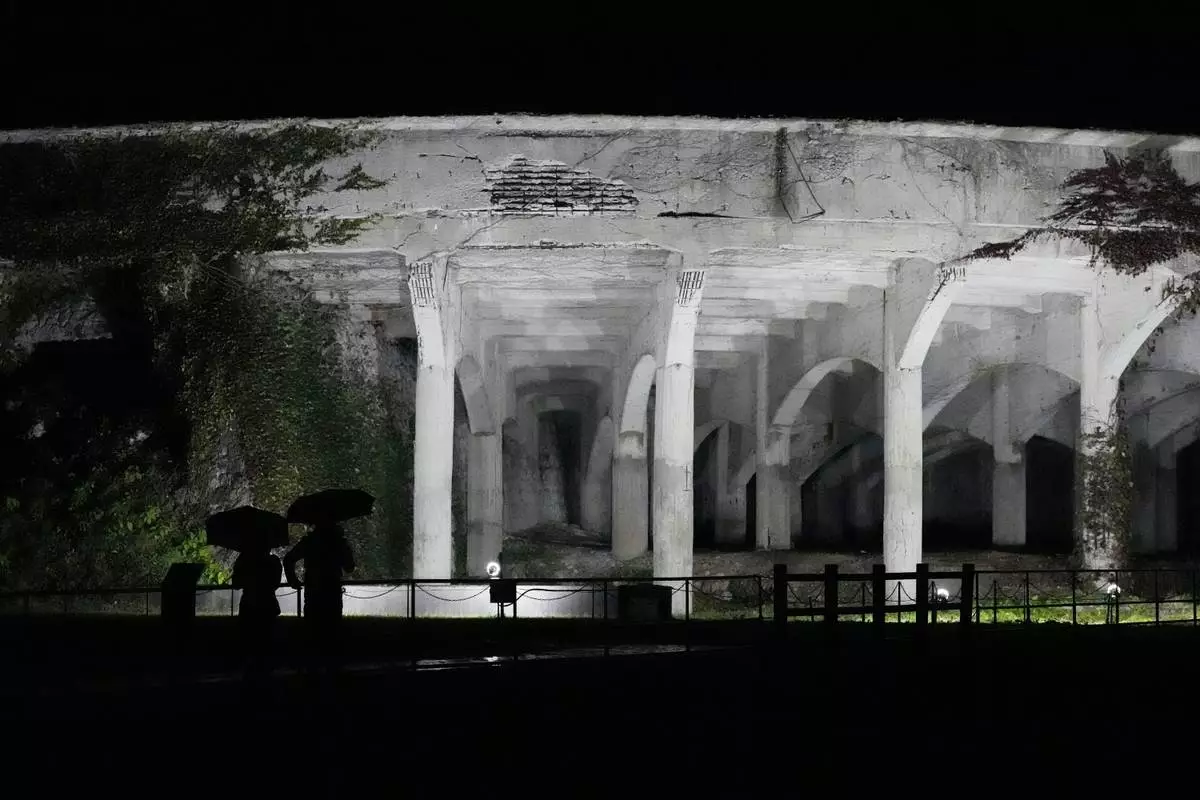
One of the industrial heritages Kitazawa Flotation Plant, a processing gold ore plant, is illuminated in Sado, Niigata prefecture, Japan, Saturday, Nov. 23, 2024. (AP Photo/Eugene Hoshiko)
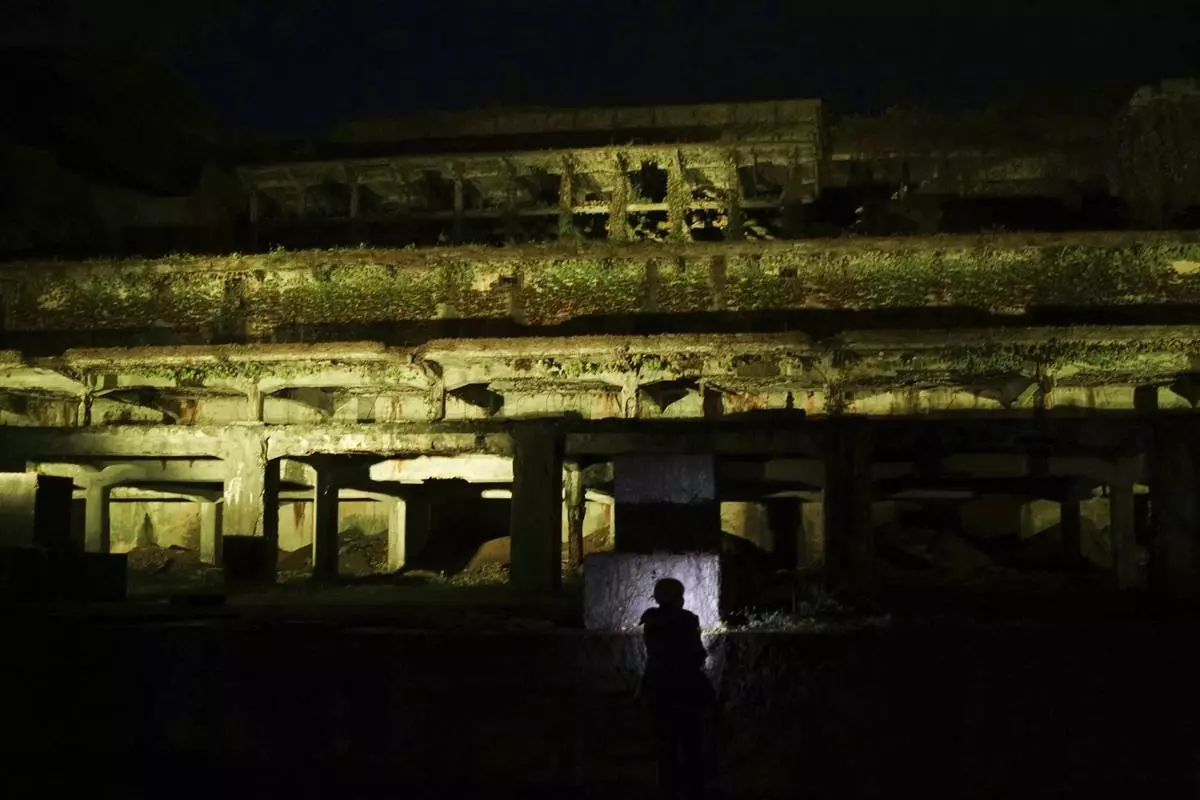
One of the industrial heritages Kitazawa Flotation Plant, a processing gold ore plant, is illuminated in Sado, Niigata prefecture, Japan, Saturday, Nov. 23, 2024. (AP Photo/Eugene Hoshiko)
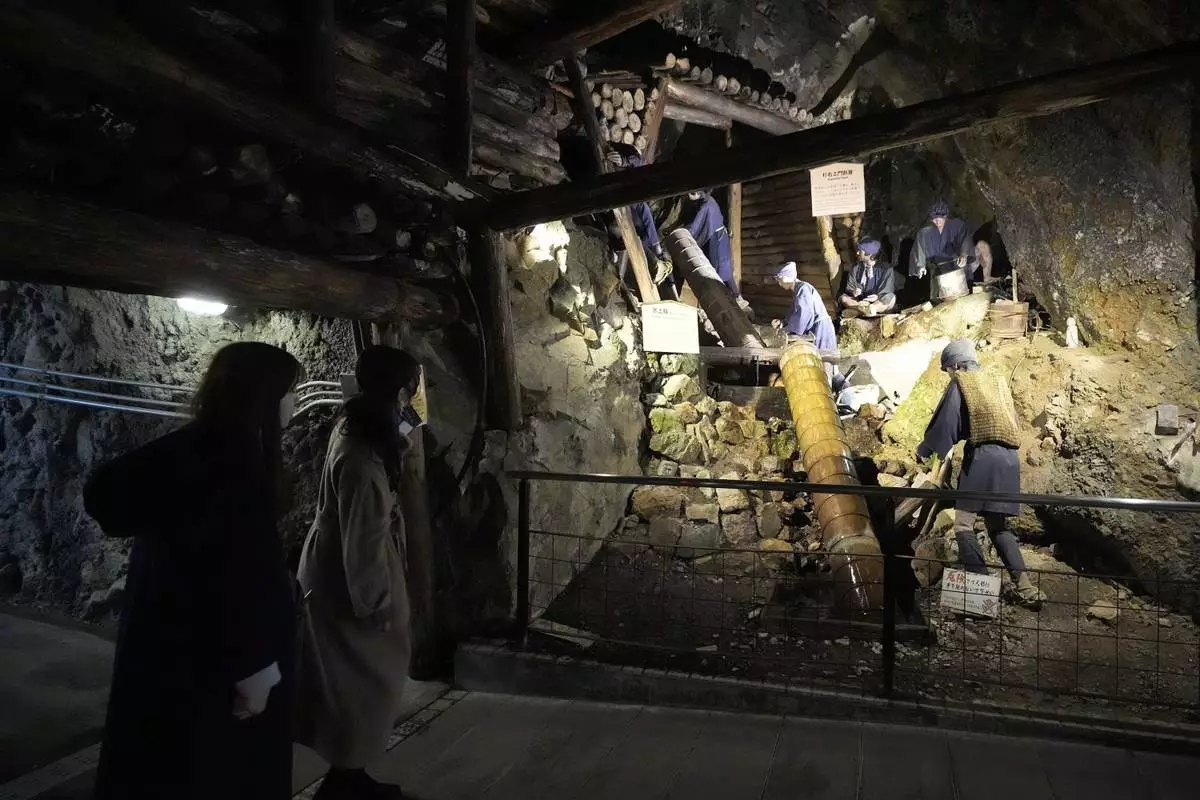
Visitors look at display at Sado Kinzan Gold Mine historic site in Sado, Niigata prefecture, Japan, Saturday, Nov. 23, 2024. (AP Photo/Eugene Hoshiko)

Visitors look at display at Sado Kinzan Gold Mine historic site in Sado, Niigata prefecture, Japan, Saturday, Nov. 23, 2024. (AP Photo/Eugene Hoshiko)
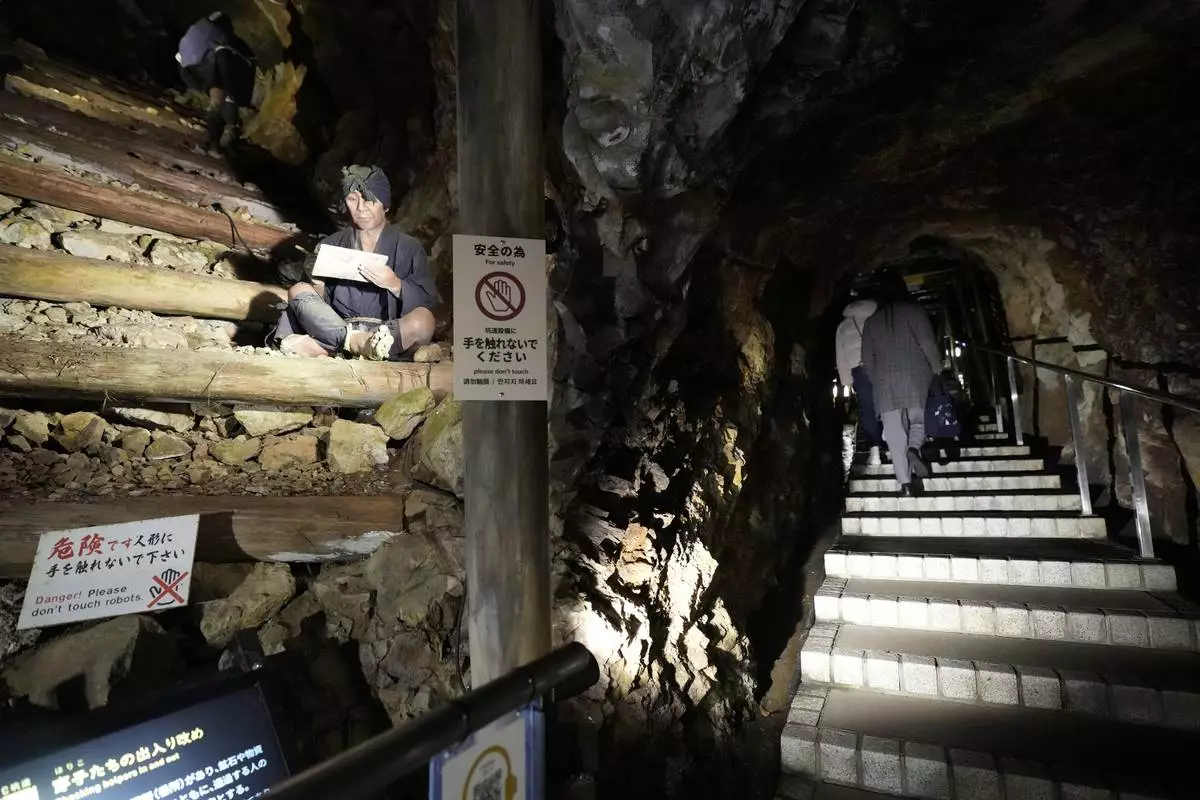
Visitors visit at Sado Kinzan Gold Mine historic site in Sado, Niigata prefecture, Japan, Saturday, Nov. 23, 2024. (AP Photo/Eugene Hoshiko)

Visitors walk though a tunnel at Sado Kinzan Gold Mine historic site in Sado, Niigata prefecture, Japan, Saturday, Nov. 23, 2024. (AP Photo/Eugene Hoshiko)
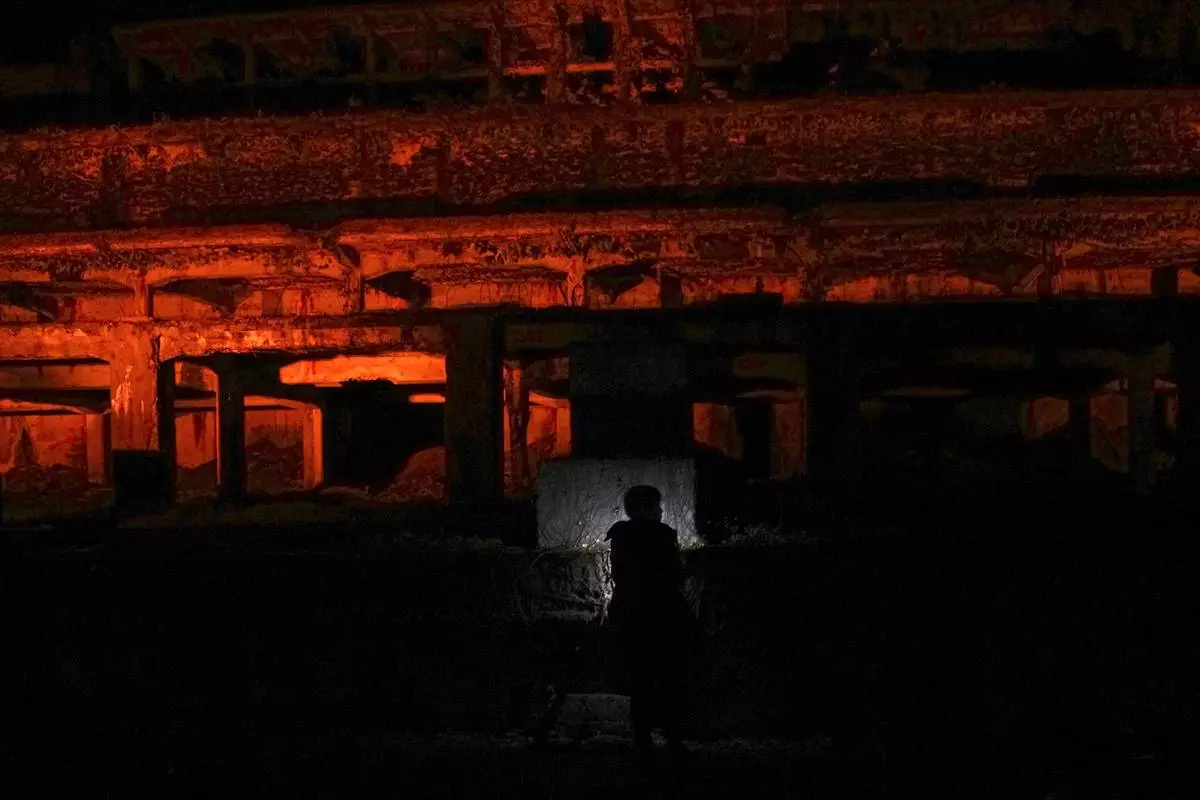
One of the industrial heritages Kitazawa Flotation Plant, a processing gold ore plant, is illuminated in Sado, Niigata prefecture, Japan, Saturday, Nov. 23, 2024. (AP Photo/Eugene Hoshiko)
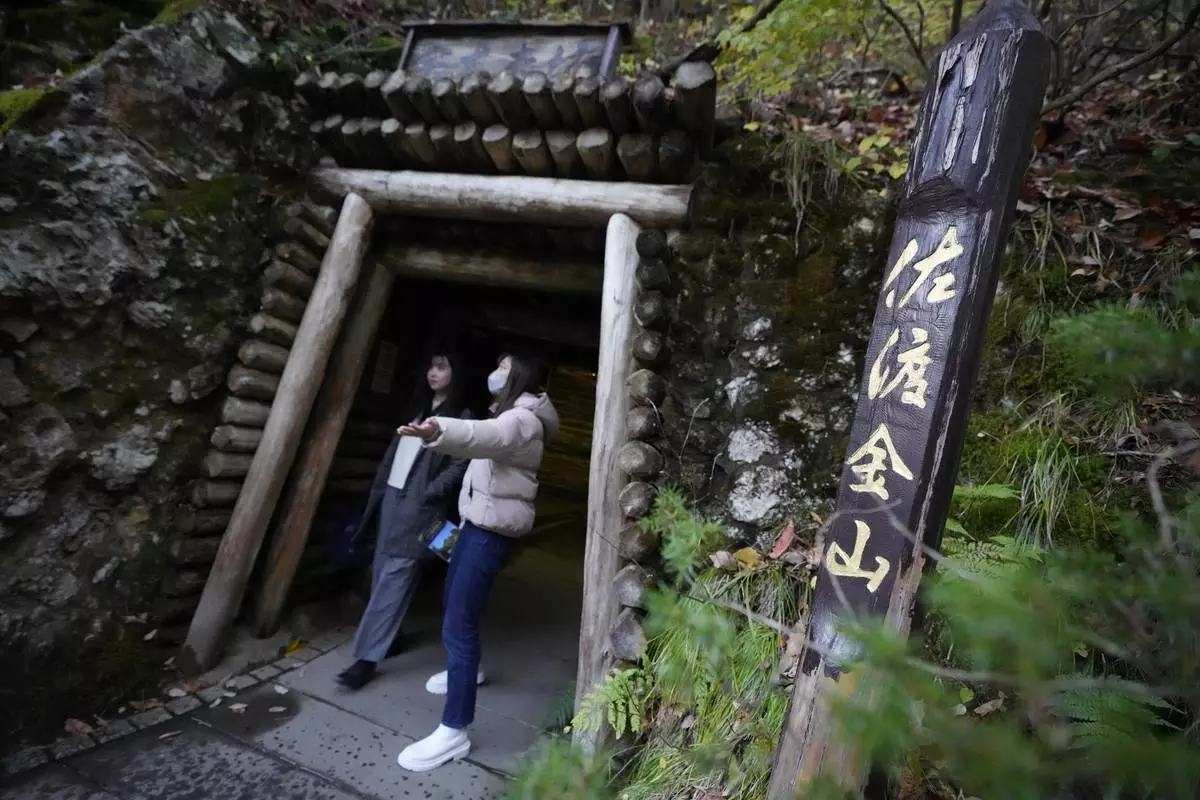
Visitors walks out Sado Kinzan Gold Mine historic site in Sado, Niigata prefecture, Japan, Saturday, Nov. 23, 2024. (AP Photo/Eugene Hoshiko)

Remains of Japan’s Sado gold mine are seen on Sado Island, northern Japan, on Aug. 19, 2021. (Keiji Uesho/Kyodo News via AP)
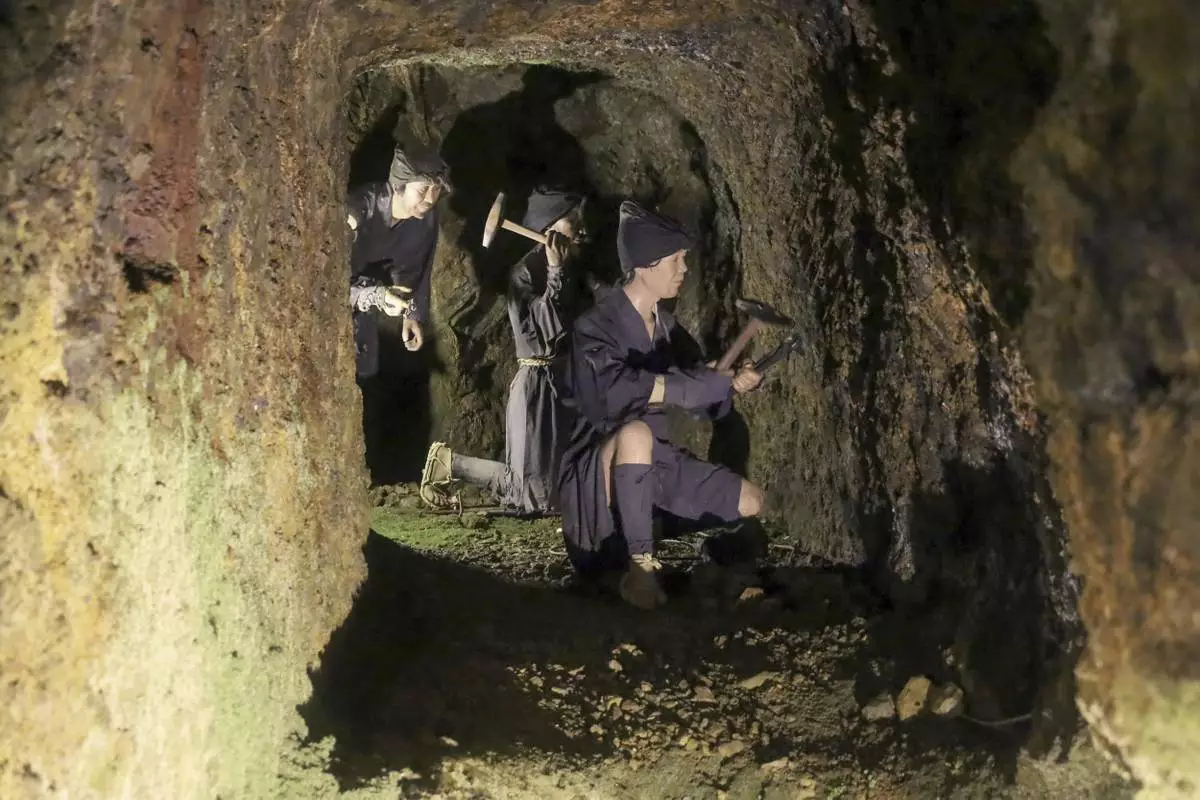
Mannequins enacting a mining scene are seen inside remains of the Sado gold mine on Sado Island, northern Japan, on July 4, 2024. (Atsushi Watanabe/Kyodo News via AP)
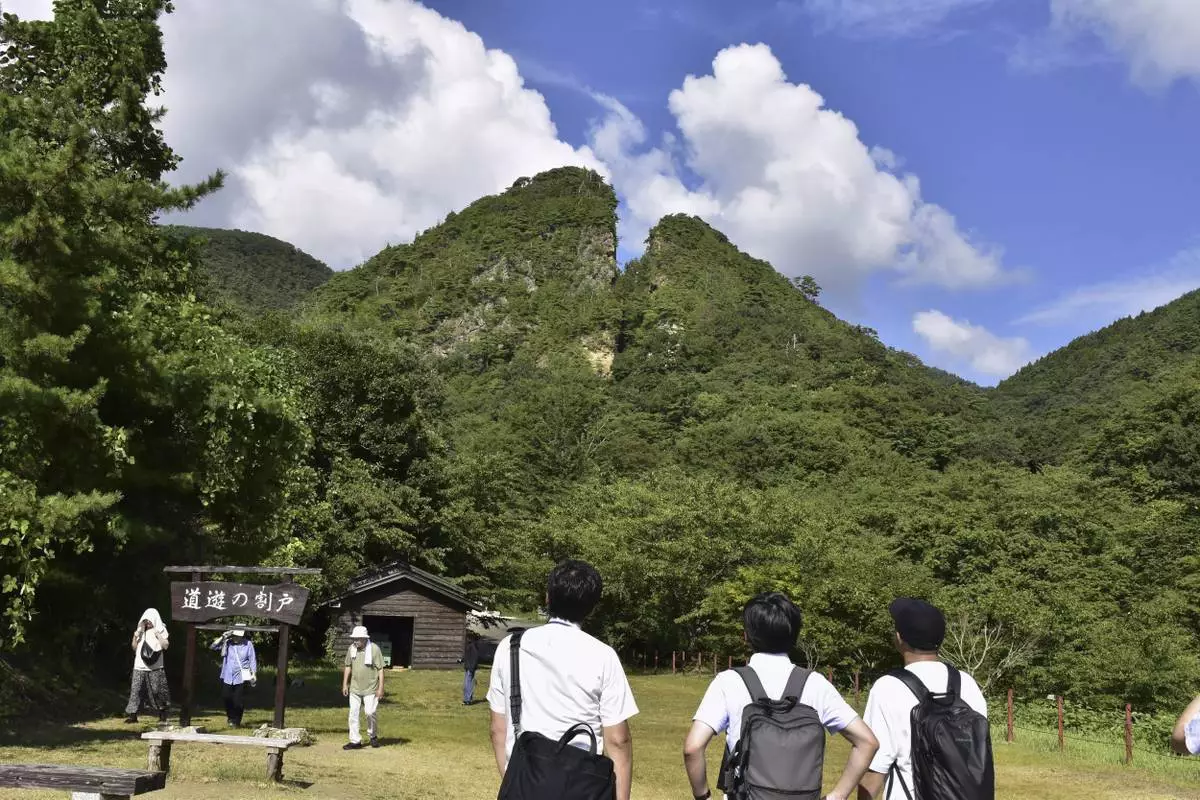
People visit remains of a Sado gold mine are seen on Sado Island, northern Japan, on Aug. 26, 2024. (Yasufumi Fujita/Kyodo News via AP)
















